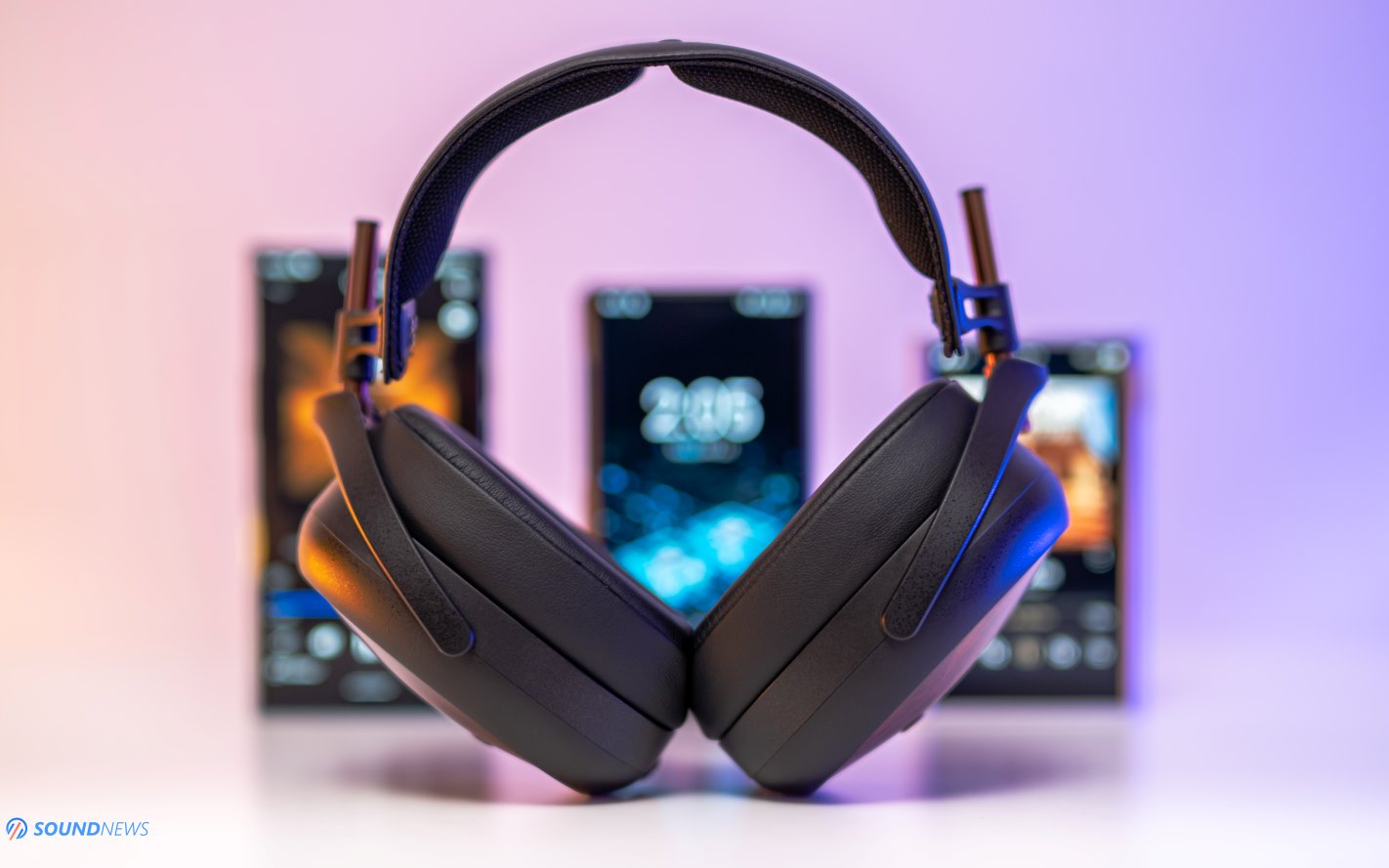Meze Liric 2 Review: Ready to Rock Your World (and Ears)

The world of high-end headphones is changing at a fast pace, driven by innovations in sound reproduction and by the rad designs brilliant minds are constantly molding. Meze Audio is already a well-known band of audio wizards with pointy hats. If you haven’t been living under a rock for the last five years or so, then you’ve definitely seen their creations at various shows or audiophile gatherings – masterpieces rooted in everything that has to do with personal audio.
Their original Liric closed-back planar headphones offered a compelling blend of comfort, isolation, and sound. However, we still had a few nitpicks about their overall sound, which could be blunt and harsh with the wrong equipment. But as the Romanian proverb goes, “Graba strică treaba” – Good things take time to polish. Meze isn’t one to rush things, instead choosing the path of authenticity with slow but powerful product releases.
The highly anticipated Liric 2 promises to be more than just an iterative update. It feels more like a cool remix, taking everything that made the original a favorite among headphiles and infusing it with a fresh dose of refinement that wasn’t quite there yet on their first-born closed-back planar. It doesn’t feel like a complete overhaul, but rather a thoughtful sonic evolution that addresses minor shortcomings we heard on the OG version while staying true to Liric’s design cues.
The first impression is often the most lasting, and the Liric 2 doesn’t disappoint. Meze’s signature use of premium materials always creates a sense of luxury right out of the box. I must say that the unboxing experience feels like opening an aged wine you’ve been waiting to uncork – exuding a timeless taste, combining the unmistakable warmth of natural woods with the cool touch of metal. Their commitment to high-quality materials extends beyond aesthetics, ensuring a level of durability that matches its intended role as a daily-driver closed-back headphone.
Comfort was a major focus of the original Liric, and I’m happy to report that its successor takes it one step further. The new earpads offer an even better fit and pressure distribution, ensuring extended listening sessions without adding listening fatigue – and they’re finally magnetically detachable! Meze’s focus on long-lasting materials and comfort is commendable, as closed-back headphones can sometimes trap heat, but the Liric 2 seems to prioritize breathability without compromising sound isolation. Needless to say, I like them already.
One key area where the Liric 2 boasts a noticeable upgrade is the included cable. The original’s somewhat cheap cable didn’t quite match the overall premium feel of the headphones. The Liric 2 addresses this issue with a thicker, higher-quality OCC copper cable that not only enhances aesthetics but also potentially improves signal transmission for a cleaner and more authentic sound experience.
Perhaps the most surprising aspect of the Liric 2 is the price tag. In a country that has the highest inflation rate in Europe, and in a world where advancements often translate to increased costs, Meze managed to deliver an improved product without upping the ante financially. This clever move makes the Liric 2 an even more compelling proposition for music lovers on the lookout for a closed-back that not only looks great but sounds as dandy as it looks.
Don’t forget that the Liric 2 isn’t just about technical advancements. Its design circles around the Romanian Knot – a symbol of how something can be both real and imaginary at the same time. All the elements of the Liric 2 were placed in perfect geometry, leaving space in the center where the magic of the sound unfolds. Meze’s latest will set you back $2000 in the USA and €2000 in Europe. As such, I will express my subjective impressions in the usual, overkill fashion. Detailed headphone measurements will follow shortly, and I will also include a few must-read comparisons with similarly priced closed-back headphones. Let the journey begin!

Design & Build Quality
After checking out most headphones released in the last 15 years or so, it’s a rare event when a pair truly captures your attention. I remember clearly, as if it were yesterday when Meze unveiled their first-generation Empyrean. The smooth lines, the attention to the smallest details, the choice of materials, the sturdiness, and the simplistic approach to headphone design – it was the embodiment of perfection. I wanted them for the looks alone; if they sounded great, that would be an added bonus.
As a person who appreciates art in all its forms, I was curious about what other designs Antonio and his team of nerdy geniuses would come up with. When I saw the first-generation Liric, my mind started picturing race cars and matte-black fighter jets. Don’t ask me why; they had this futuristic vibe I kind of liked. They certainly had the Meze look, with a few minor adjustments that made them smaller, lighter, and more transportable. The traditional headphone structure is gone; the headband is attached directly to the yokes, which pivots the cups a full 360 degrees. Before you ask, yes, you can lay them flat on your table, and yes, I’m excited about this!
The original Liric already looked intriguing and, dare I say, unique, borrowing just a few design cues from its open-back siblings. The comfort levels were great with the first iteration, and the chosen materials would last for years. Since every single part could be exchanged with a new one, there wasn’t a point in starting a new design from scratch. The only things that differentiate the OG from the Liric 2 are the cup covers – having a leathery texture on the OG and real Macassar ebony wood on the second iteration – and another, much more important change. It was a matter of when, rather than if, the magnetic earpads rocking the Elite and Empyrean 2 would be re-engineered for portable use. Liric 2 is finally using detachable earpads! This opens a slim window to future earpad upgrades coming from Meze, or from third-party earpad makers such as PadForce or Dekoni.
I need to be a critic, and I’m trying hard to nitpick about these, but sadly, my mind can’t find a flaw or an oversight. I will be comparing them shortly with their predecessors and with similarly priced closed-back headphones – though I doubt those others stand a chance when it comes to sheer looks or material choices.
If you go to Meze’s website and check out the Liric 2 page, you’ll soon realize that more than half of the information highlights looks and build quality, with a much smaller portion dedicated to the technology involved. These guys are proud of their achievements, and I’m glad there are a few brave souls who care not only for the sound but also for Mother Nature by using sustainable and long-lasting materials.
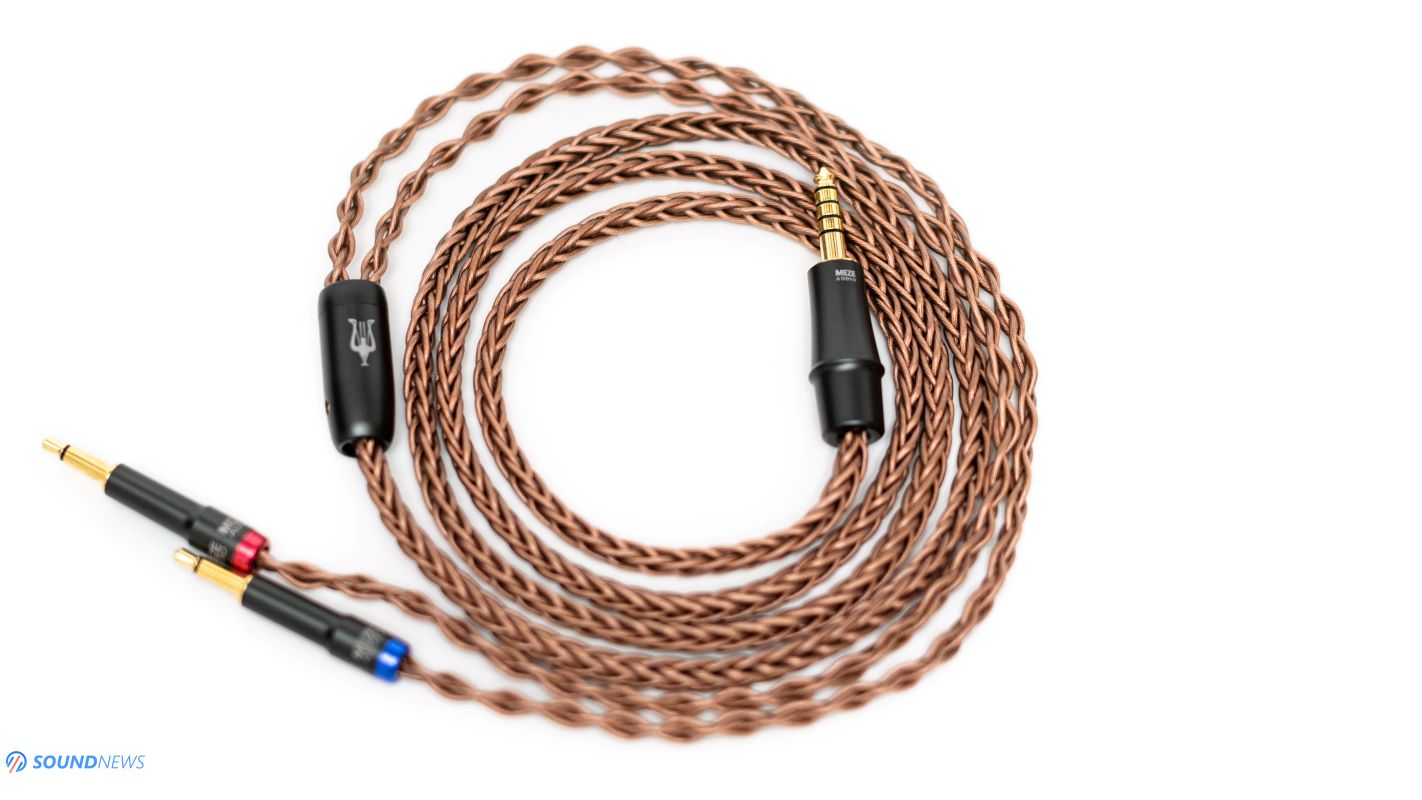
Cable Quality
Before we move on to sound impressions, I want to draw your attention to one important aspect many headphone builders overlook: cable quality! The original Liric came with a fairly decent cable, which the Liric 2 still includes. It’s flexible enough, doesn’t suffer from nasty microphonics, and seems sturdy enough. However, if you wanted fancier cables, better conductors, or a wider variety of connectors to work with your gear, you needed to invest in a third-party cable or one provided by Meze at an extra expense. The best pure-copper PCUHD cable that Meze offered for the Liric would cost you $249, and you could choose between a 3.5mm, 4.4mm, or 4-pin XLR termination. The coolest part? This very cable is now bundled with the Liric 2 at no extra cost! That’s right, the famous PCUHD copper from the Furukawa plant in Japan is offered for free, alongside the stock cable the original Liric came with. Antonio and his team just won serious style points for not pushing us toward an endless cable upgrade path. Kudos to that!
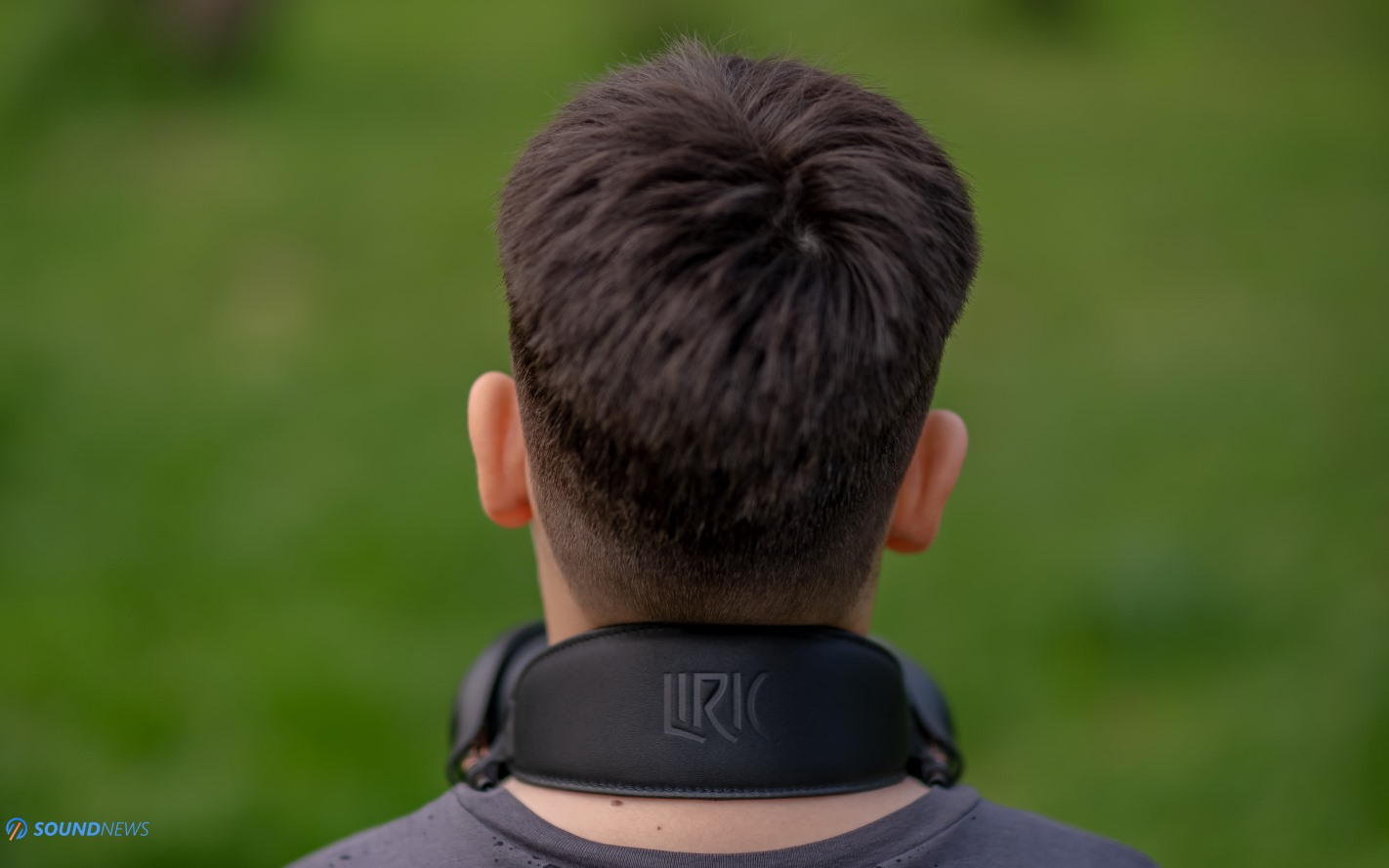
Comfort Level
We have a smaller driver compared to the full-sized Elite and Empyrean 2, and naturally, the earcups are smaller as well. My elven ears, however, didn’t feel cramped. Nor did I experience higher pressure than usual, and in true Meze fashion, I find them comfortable for long-term use. The temperatures are steadily rising outside – we had 35°C (equal to 95°F) yesterday – and I decided to take them for a 30-minute walk. I could feel my ears getting warmer when returning home, but I didn’t experience sweaty ears in half an hour, and I would probably use them outside more often than indoors.
The Meze Liric 2 weighs 427 grams, 7 grams heavier than their flagship Elite, and you can definitely feel their mass and sturdiness – which is a good thing in my book. While heavier than your average all-plastic Bluetooth headphones, the weight distribution around the ears is even and the padding on top is soft enough to nicely distribute the weight. You won’t notice them after carefully adjusting them to your head size. Since we have deeper earpads than usual, your ears won’t touch the inner fabric or the driver assembly. The clamping force is minimal, and the position of the rods doesn’t influence the side pressure that much – another major quality-of-life improvement. Some headphones become uncomfortable once you lower the position of the rods, but the Liric 2 isn’t one of them. I could go on and on about how much thought was put into their build, attention to detail, and comfort levels, and that still wouldn’t be enough.
Once I experienced magnetic earpads on the Empyrean and Elite, I wondered why nobody had come up with such a clever idea before. The whole process takes a second, and I don’t need to apply lots of pressure to remove or put them back. Here’s hoping Meze might come up with vegan or Alcantara pads that will work even better on hot, sunny days.
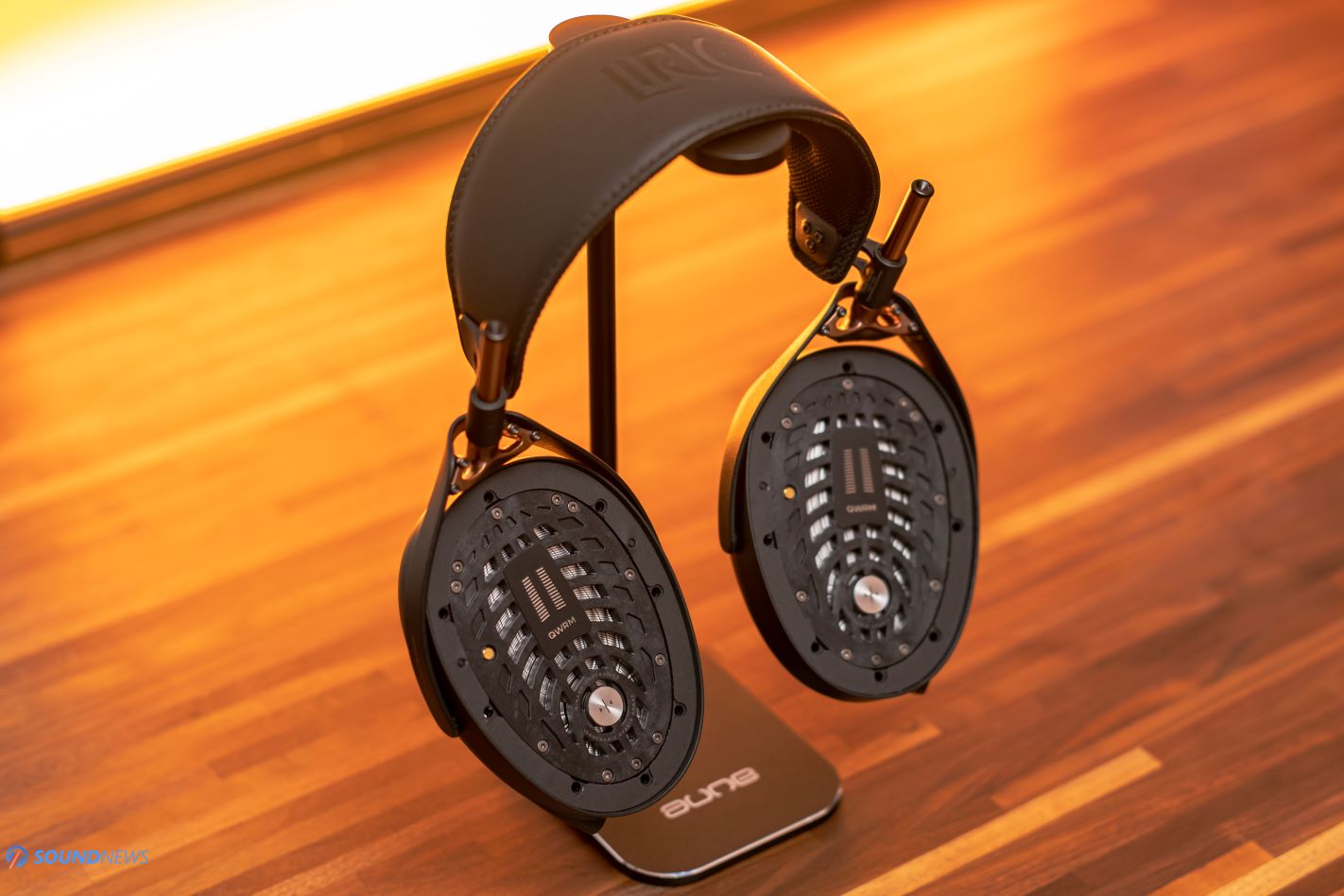
Tech Inside Meze Liric 2
As Meze puts it: “LIRIC 2 features state-of-the-art technology developed by Rinaro, re-engineered for day-to-day use. The MZ4 Isodynamic Hybrid Array driver was purposefully scaled down and tuned to deliver a similar audio experience with its larger counterparts found in the Empyrean II and Elite. Combined with the closed-back design, it helps preserve the original clarity and emotion of your favorite music through enhanced sound and minimized external noise. Each driver is entirely hand-assembled and tested in Rinaro’s industrial facility in Ukraine.”
The Liric 2 is currently Meze’s flagship-grade closed-back planar headphone, crafted for use both at home and on the go. A tremendous amount of time was invested in developing their driver assembly. While we still have the good old Rinaro Isodynamic Hybrid Array, shaped to resemble human ears, the driver size has been reduced from 102 mm by 73 mm to 92 mm by 63 mm. This slightly reduces the mass of the driver from 75 to 71 grams.
The diaphragm itself weighs a mere 0.08 grams and has an active area of 3507 mm2. Double-sided magnets are symmetrically placed on either side of the diaphragm, creating a magnetic flux of 0.3 Tesla for uniform activation across the entire diaphragm surface.
The biggest change compared to the original Liric is the development of a Quarter Wavelength Resonator Mask (QWRM for short). This CNC-machined metallic piece covers select openings in the driver frame, effectively attenuating high-frequency peaks above 7 kHz for a less fatiguing listening experience. I might struggle to pronounce that acronym with my strong Eastern European accent, but I’m thrilled to know that the upper treble won’t be as hot anymore. Brightness? What brightness?
If you’re curious about every step Meze took in meticulously refining the MZ4 drivers, I recommend checking out the Liric 2 page right here. What makes these drivers stand out from typical isodynamic (planar) designs is the use of dual coil configurations. As Meze explains, “The use of dual coil arrays not only creates a balanced frequency response across the entire range but also allows for better frequency targeting within different areas of the ear, improving acoustical perception in the upper frequency range.”
In simpler terms, you’ll notice a spiral coil forming a circle at the lower part of the driver. This coil is more efficient at reproducing mid and high frequencies, channeling sound waves directly into your ear canal. The switchback coil (the blue one) excels at reproducing low frequencies (the bass) and is positioned in the upper part of the driver. This clever design solves a common issue with traditional planar magnetic arrays, where reflected signals enter the ear canal with different time delays, potentially muddying the imaging and holographic effects.
As you’ve likely guessed, these are closed-back isodynamic (planar) headphones that use oval-shaped drivers with an unconventional size of 92 mm by 63 mm. While the Liric 2 shares the same nominal sensitivity of 100 dB per 1mW as its older sibling, doubling the impedance to 61 Ohms makes them slightly less efficient. You might need to crank the volume one to three clicks higher, depending on your source and amp. They’re not super difficult to drive, but they’ll benefit from a decent current output for optimal control of their drivers. For the best results, consider desktop DAC/Amp combos, desktop headphone amplifiers, or some of the latest portable devices from FiiO, Shanling, HiBy, iBasso, Astell&Kern, and others.
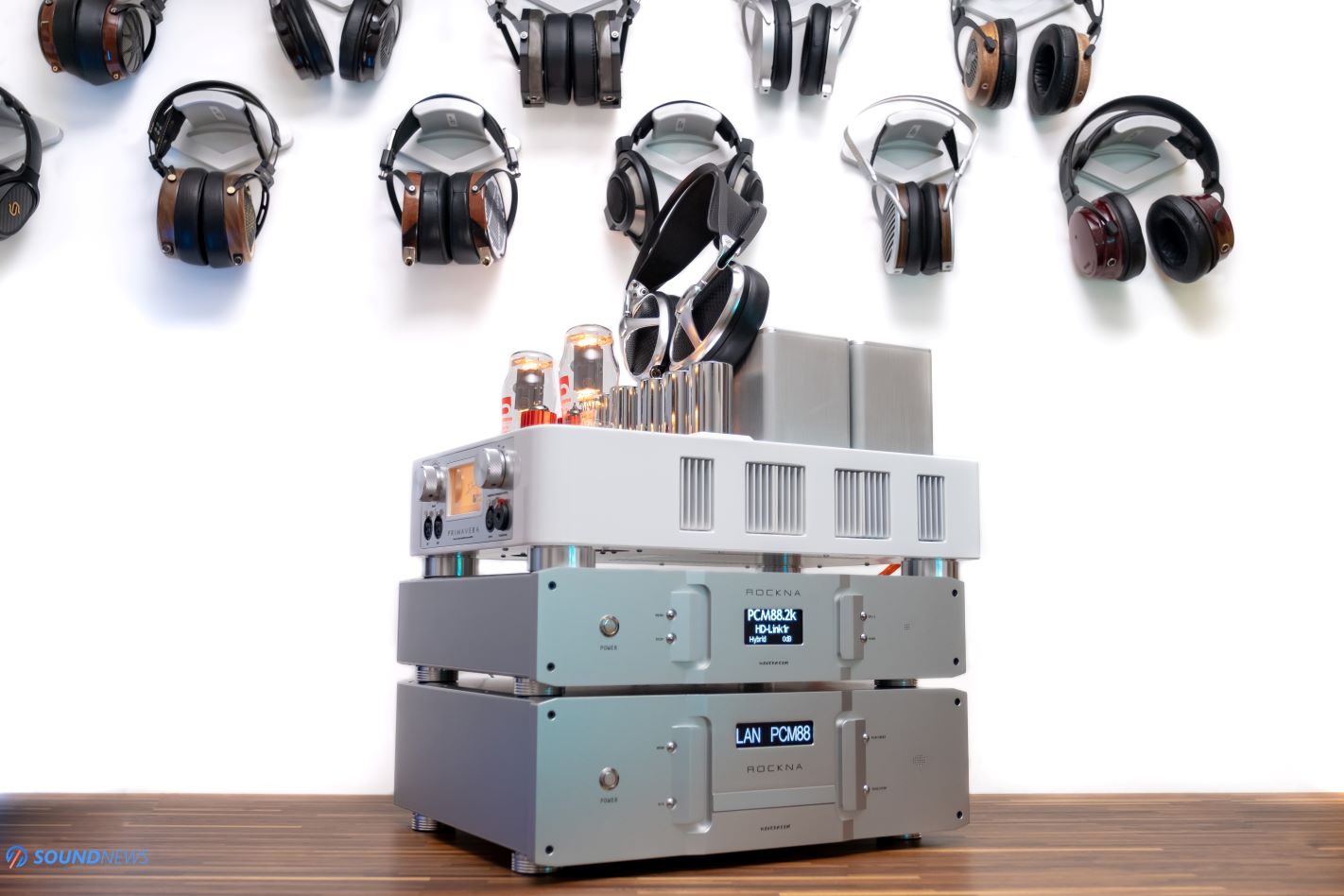
Test Equipment
A flagship closed-back pair of headphones will need a flagship headphone setup to shine at its best, and that’s why I went overboard with electronics. I used an Ansuz Power Switch D3 ($5800) Ethernet switch connected via Ethernet to a Rockna Wavedream NET ($10,000) music server filled with DXD and DSD content. It also functions as a Roon endpoint connected to streaming services such as Qobuz and Tidal. A Rockna Wavedream Signature XLR DAC ($20,000) follows via an I2S connection, and then marvelously sounding Trafomatic Audio Primavera ($15,000) and Enleum AMP-23R ($6250) headphone amplifiers come next, which will squeeze the last drop of performance out of them. Everything is powered by a KECES IQRP-1500 ($2300) isolated power conditioner. The media converters (Ethernet to Optical and vice versa) and the wireless router are powered by a KECES P14 linear power supply. Crystal Cable Reference Diamond2 interconnect cables and Crystal Monet power cables have been used all around. Out of pure curiosity, I also tried them with several portable devices, which will be mentioned in a separate chapter. With that out of the way, let’s hit some eardrums! 🤘
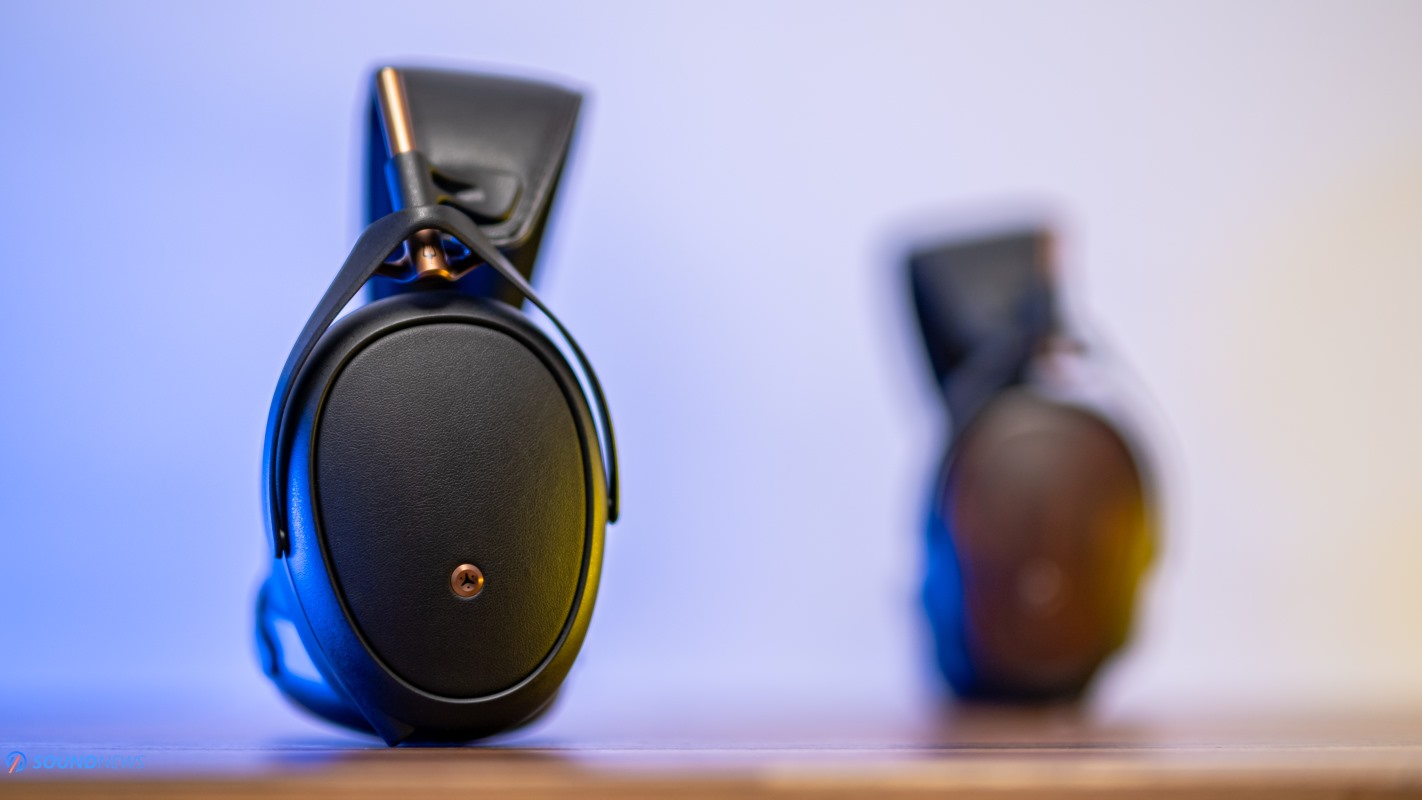
Sound Performance
I. Liric’s Humble Beginnings
Alright, brace yourselves for a confession: I wasn’t exactly head over heels for the original Liric. Yep, I said it. The sound was cozy, almost too intimate, and the soundstage? Well, let’s just say it wasn’t exactly blowing my socks off. Instead of feeling like I was standing in the middle of a sonic battlefield, I felt like I had two oval-shaped ear companions whispering sweet nothings right next to my ears, leaving me swiveling my head like a confused owl. It was like a trip back to the ’60s when mono records were slowly making way for stereo. Those extreme left-right stereo effects? Yeah, they’re still lingering like stubborn houseguests, but that’s a story for another time.
The Liric 2’s sound didn’t quite jump out in front of my face; it more or less meandered around my ears, playing hide-and-seek with my senses. I found myself constantly turning my head like I was watching a tennis match. And let’s talk about those trebles – they were sharp and defined, but sometimes a tad too enthusiastic, like a drummer going wild on a cymbal solo, threatening the integrity of my eardrums. Pop on a Topping or SMSL stack, and you might as well start dancing with polarized sunglasses to the beat.
On better days, however, armed with the right source, amplifier, and cables, the Liric sounded pretty darn impressive! There was still a bit of warmth, the midrange sounded natural to me, almost lifelike, and these still had a good deal of technicalities since we’re dealing with flagship-grade planar drivers. The sound drastically changed depending on the material and electronics used. You could feel the power behind those drivers, as the sound could go from “meh” to outstanding in a matter of seconds. Sure, it still had some quirks, depending on what gear and tunes I threw at it, but beneath it all, I could sense the potential, just waiting to be unleashed.
Despite its flaws, closed-back headphones are a necessity for some, and two of my friends preordered them and never looked back. I totally understand why they were hyping them up – at their price point, the Liric offered a strong proposition back then. With the legendary Meze build quality, they looked like a million bucks next to my HiFiMan cans.
Now, I’m not saying the DCA Stealth or the Kennerton Rognir were shaking in their boots – after all, they cost a pretty penny more than the Liric. But what I did feel was a flicker of potential, a spark that I’ve seen before with their 99 Classics and 99 NEO. It’s like they’re sitting on a goldmine just waiting to be unearthed.
And let’s not forget the Meze team – they’re not just your average group of audio wizards trying to make a buck. These guys eat, sleep, and breathe music, and half of them can probably shred on a guitar better than your average rockstar. They didn’t need to hit the drawing board again because the Liric was already a work of art. All they needed was to fine-tune it, aiming for stronger dynamics and a wider soundstage from a pair of closed-back headphones. It seems like they’ve achieved their goals.
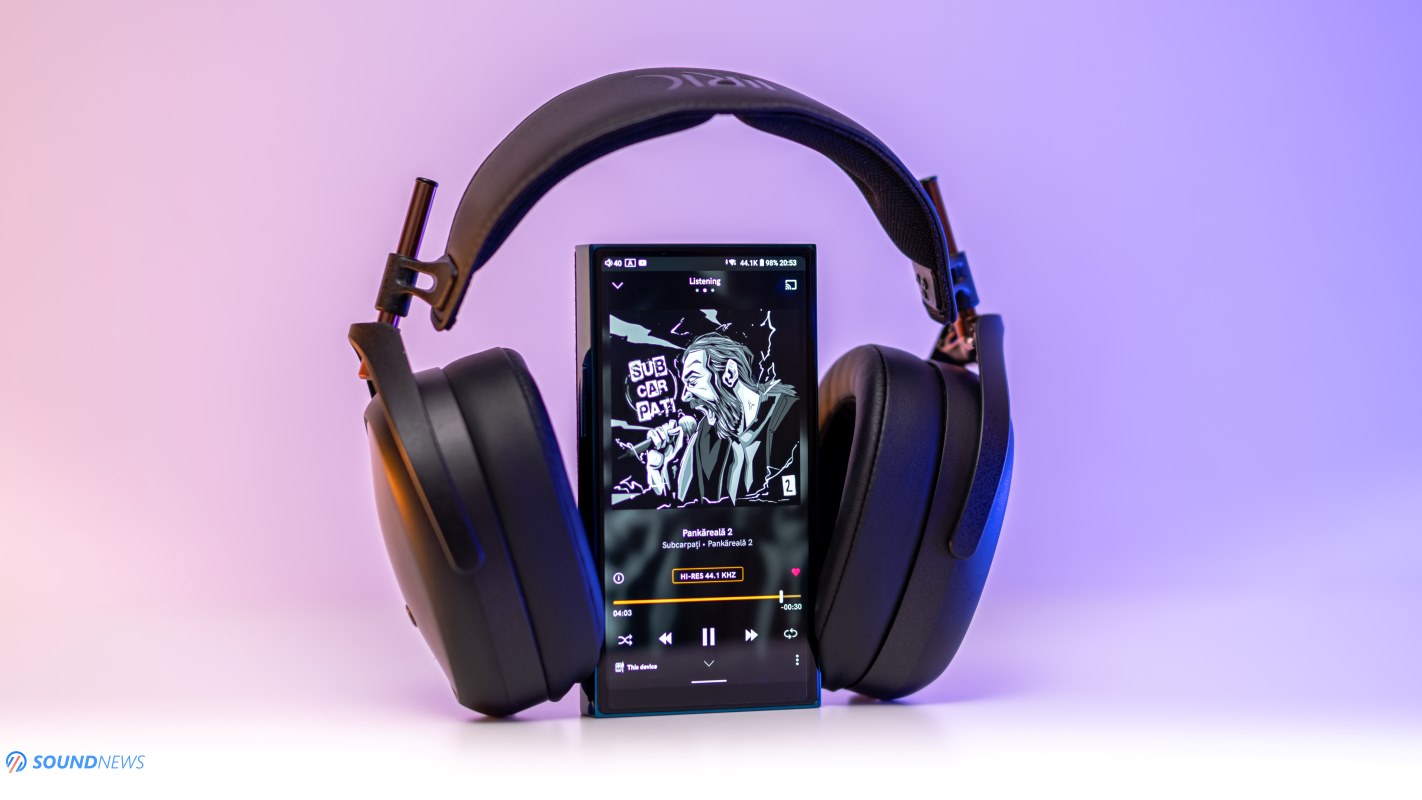
II. Power Requirements & Amp Pairings
When Meze created the first-generation Liric, their main goal was to craft a relatively easy-to-drive pair of closed-back planar magnetic headphones that would borrow some skills from their top-tier offerings, all while keeping the price accessible. People were genuinely surprised to hear about a portable Meze Elite – one that could be driven with portable digital audio players (DAPs) and even a few USB dongles. With a sensitivity of 100 dB per 1mW of power and a 30 Ohm impedance, many folks used them on the go with decent portable DAPs, achieving ear-splitting volume levels.
While the Liric 2 boasts a similar sensitivity, its impedance has doubled. As a direct result, more power is needed to achieve the same sound pressure level. If you’re upgrading from the original Liric, you’ll need to crank up the volume higher. What worked with the original Liric might not cut it for its successor. Case in point: Shanling’s M3 Ultra and HiBy’s R6 PRO were mighty powerful with the first-gen Liric, but I feel that higher-powered devices are needed to squeeze the same level of dynamics from the newly released Liric 2. This is probably the only nitpick I have with the Liric 2, as few of the USB dongles I own can satisfy my headbanging needs anymore. HiBy’s FC6 and Aune’s Yuki barely work, easily maxing out yet still leaving me craving more juice.
It seems even the Meze Elite doesn’t require as much power to be fully driven, which shouldn’t come as a surprise. A smaller driver naturally requires additional power to deliver a similar sound pressure level (SPL) compared to a larger one. Think of it like the difference between smaller bookshelf speakers and those massive floor-standers.
On a positive note, you can still drive the Liric 2 with more powerful DAC/Amp combos, Bluetooth gadgets, or regular DAPs. Out of the units I tried, the FiiO Q7, Q15, Shanling H7, and Topping G5 performed best. If you’re still rocking dedicated portable audio players, anything that can push at least 500 mW will sound great with the Liric 2. In my experience, nothing beats HiBy’s RS8 and R8 II, followed by FiiO’s M17 and M23, and Shanling’s M7. With those devices, the dynamics were unleashed, and the bass hit hard, sounding effortless and tightly controlled.
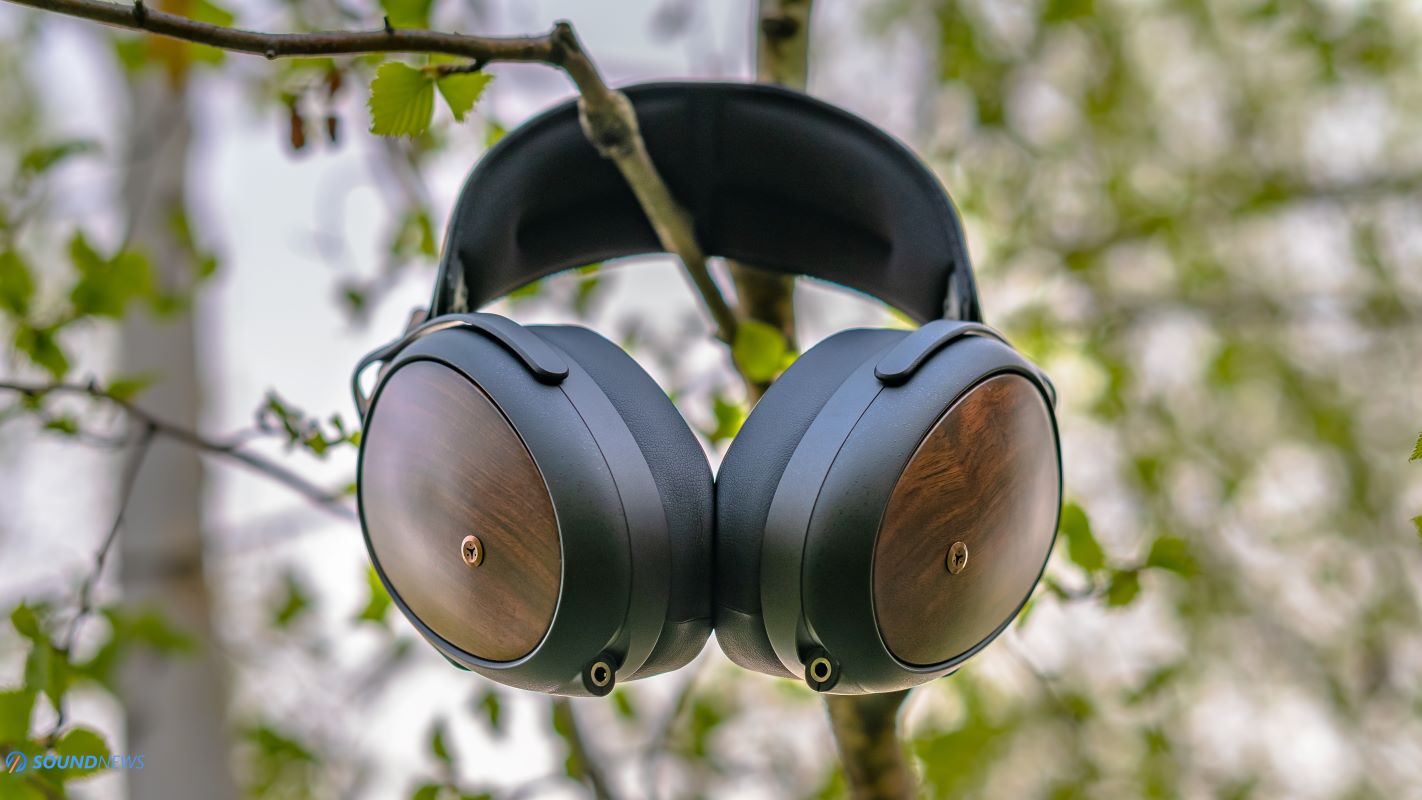
III. Dynamics & Transient Response
Probably the coolest part about the Liric 2 is its ability to awaken positive vibes in mere seconds, delivering hard-hitting slams when the music calls for it. Since the impedance increased, requiring more power to unlock maximum dynamics, Meze implemented a clever trick to preserve bass energy even with less-than-ideal sources. They gently boosted the mid-bass area by around ~4dB, adding fun and warmth to the whole experience.
As an owner of the 109 PRO and Elite, I can confidently say that the Liric 2 takes the crown for the most fun Meze headphones yet. Sure, we’re not talking about an ultra-linear set of cans, but who cares when all I want to do is hop around, headbang, and dance to local folk-rock tunes? If you have a halfway decent DAP or portable DAC/Amp combo, you won’t even have time to count to ten before your foot starts tapping.
Case in point: Subcarpați just released their long-awaited sequel, Pankăreală 2, on streaming platforms (Tidal / Qobuz). This album once again reminds me that blood is thicker than water, unlocking my funky genes as soon as Bean drops the beat and the flute starts swirling around my head. If you’re curious about Eastern European folk mixed with trap and hip-hop, open your mind and go with the flow!
I’m sure their leather pads are enhancing the low-end extension, and I can’t deny that I enjoy their fuller-bodied sound with portable devices. But connect the Liric 2 to a well-designed desktop rig, and they take flight, with significantly improved dynamics. You can sharpen their fast transients with desktop solid-state amplifiers, and for the ultimate in soundstage, nothing beats a transformer-coupled tube amplifier. The most exhilarating amp pairing with the Liric 2?
Enleum’s AMP-23R controlled their drivers like nothing else could, enhancing the bass quality by revealing additional nuances and layers. Add a world-class DAC like the Rockna Wavedream Signature, and you’ll be up all night. The Liric 2 has everything it takes to impress both music lovers and audiophiles, as long as the amp provides enough power and headroom.
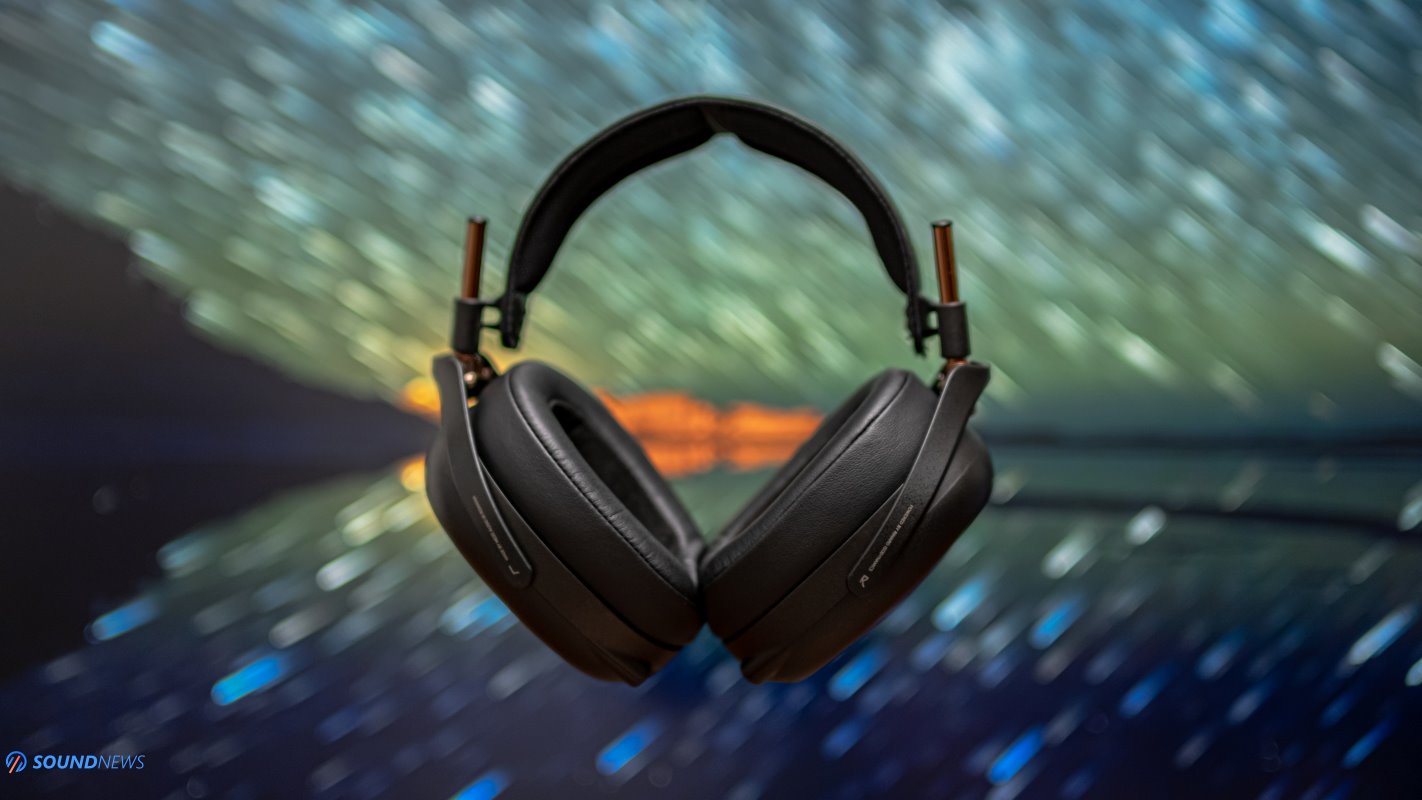
IV. Soundstage & Imaging
Without a doubt, soundstage and imaging are among the most significant improvements Meze addressed with the Liric 2. As I mentioned, the close and personal sound of the original Liric just wasn’t my cup of tea. I couldn’t detach myself while listening, and 1970s jazz and blues rarely had anything playing directly in the middle. Extreme stereo effects aren’t as fatiguing on open-back headphones, and you can even eliminate the issue altogether with a potent tube amplifier or crossfeed circuit. But even on tubes, the original Liric wasn’t playing with my imagination, never letting sounds escape their confines. The soundstage was two-dimensional, lacking any real sense of depth. When you need closed-back headphones, however, you accept the inherent drawbacks – and for a while, the first-gen Liric was good enough.
Then the Kennerton Rognir ($3,430) completely spoiled me. The stage, the expansiveness, the depth, the openness, the naturalness… I couldn’t believe my ears. They outperformed the vast majority of my open-backs…even rivaling some top-tier open-back planars. After seeing the acoustic treatment inside the cups and the mesh-covered vent to release excess air pressure, I realized that clever engineering could make even closed-back designs feel as spacious and expansive as open-back variants.
I secretly hoped the Liric’s successor would be a more affordable Rognir, pushing sounds toward the center instead of my peripheral hearing. And it seems my prayers were answered – the Liric 2 is no longer intimate, transforming into an on-stage presentation. It’s a challenge to describe just how much wider and deeper the sound feels, as these things are subjective, but I can confidently say they’ll outperform the likes of the HD660S2 and Ollo S5X. Heck, even the Hifiman Susvara won’t sound as spacious on a mid-tier amp. Note separation vastly improved sounds no longer fight for dominance, and you won’t need to close your eyes to untangle messy recordings.
Everything feels more natural, there’s less ringing in the highs and fewer unwanted vibrations to ruin your experience. As a direct result, the music breathes more freely, and finally, the sounds aren’t confined to your headspace but float all around you. The soundstage is seriously impressive for a closed-back, and compared to similarly priced headphones like the Fostex TH-900 MK2, the Liric 2 feels almost twice as expansive on all axes.
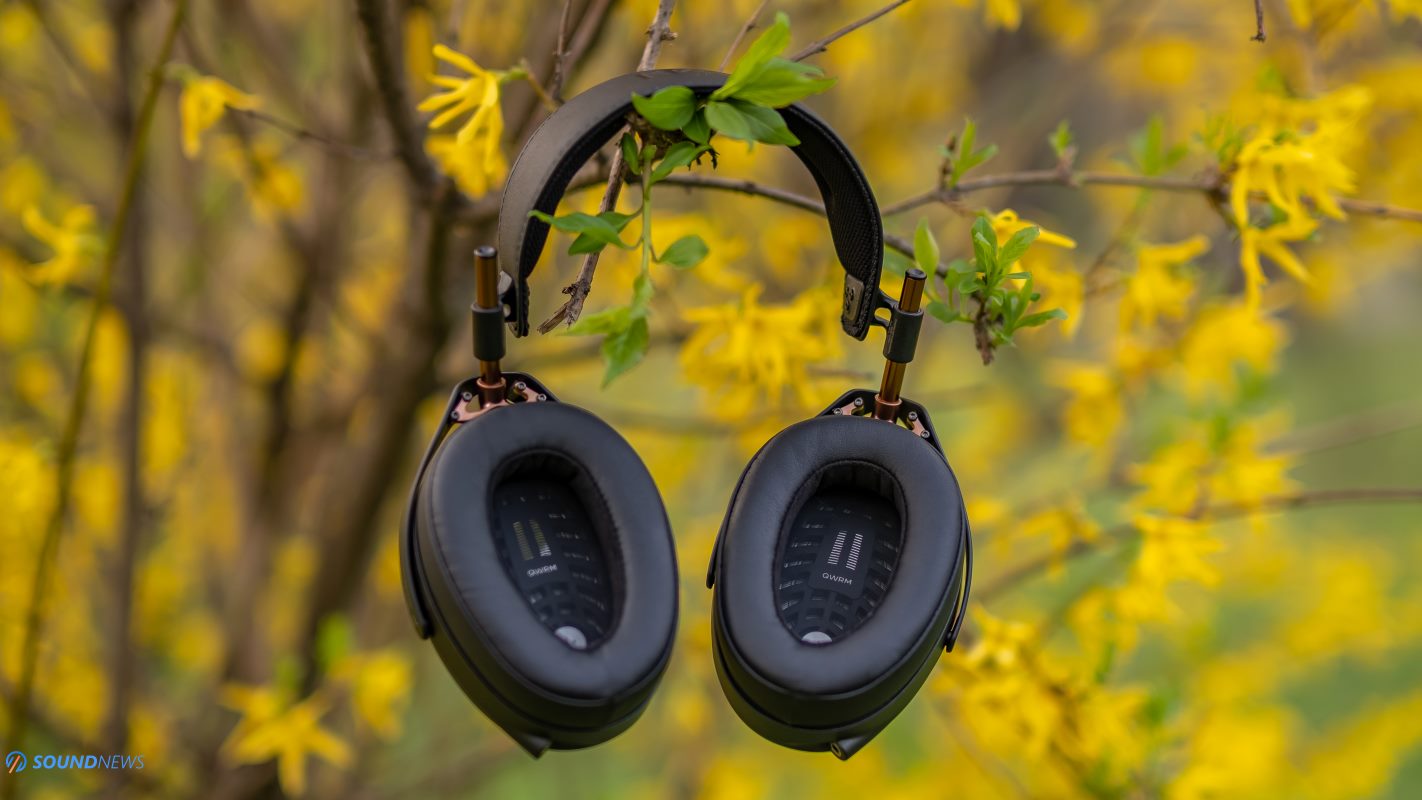
V. Detail Retrieval & Transparency
Developing the QWRM (which covers select openings in the driver frame to effectively attenuate frequencies above 7 kHz) and applying it to the Liric 2 triggered a chain reaction that impacted more than just the frequency response. By suppressing excess in that upper register, your focus naturally shifts, allowing you to hone in on any frequency you like. The Liric 2 doesn’t necessarily sound clearer or more detailed in a raw technical sense, but it’s much easier to focus on specific elements. The sounds feel less forced and that tamer upper region reveals extra nuances in the bass and midrange.
The Liric 2 achieves a more natural presentation, with a healthy dose of lower-midrange and mid-bass, and less peaky treble, ultimately resulting in a more relaxed and balanced listen. So, can you have your cake and eat it too? I think so, and the Liric 2 is a testament to that. People sometimes confuse extreme resolution and detail with harsh treble and excessive sharpness – that’s not quite how resolution works. In fact, by softening a high-end peak, the Liric 2 feels more resolving everywhere else. You won’t need a long playlist, your finest source, or a glass of wine to appreciate the added air and nuance around every musical note.
Antonio Vivaldi: The Four Seasons by New York Philharmonic (Tidal / Qobuz). Throughout his life, Maestro Antonio Vivaldi composed a vast number of operas, some true masterpieces and others less inspired, but many of them will forever have a place in our hearts. Even if I don’t listen to opera and classical music often, many of you are familiar with his famous arias and choruses. This piece is a particularly difficult recording for closed-back headphones to reproduce due to its complexity. The Meze Liric 2 shows no sign of strain, effortlessly pushing every nuance and detail as if the musical spectacle unfolds right before your eyes. The orchestra’s power combines with minute details – foot movements, the sound of inhales and exhales – none of it is lost or muddied, creating an airy and well-structured soundscape. The music flows brilliantly, leaving you no choice but to close your eyes and conduct that performance with your own hands. When the album ends, you’ll be yearning to relive the magic again. Beyond its clarity and airiness, this is also one of the most dynamically charged recordings out there, a benchmark for many stereo and headphone systems. It’s one thing to reproduce a single musician, but the grandiosity of classical music with dozens, sometimes hundreds of instruments playing simultaneously always inspires awe. The constant shifts between slow to fast, quiet to loud moments breathe life into the instruments, creating an almost supernatural atmosphere, transporting you directly to the splendor of the Venetian Renaissance. We hear delicate violins, cellos, harps, and woodwind instruments join in, then an explosion of sound that takes your breath away before gently fading. A reference headphone rig plays a major role in delivering these unforgettable moments, but it would all be for naught without a reference pair of closed-back headphones to unfold the magic.
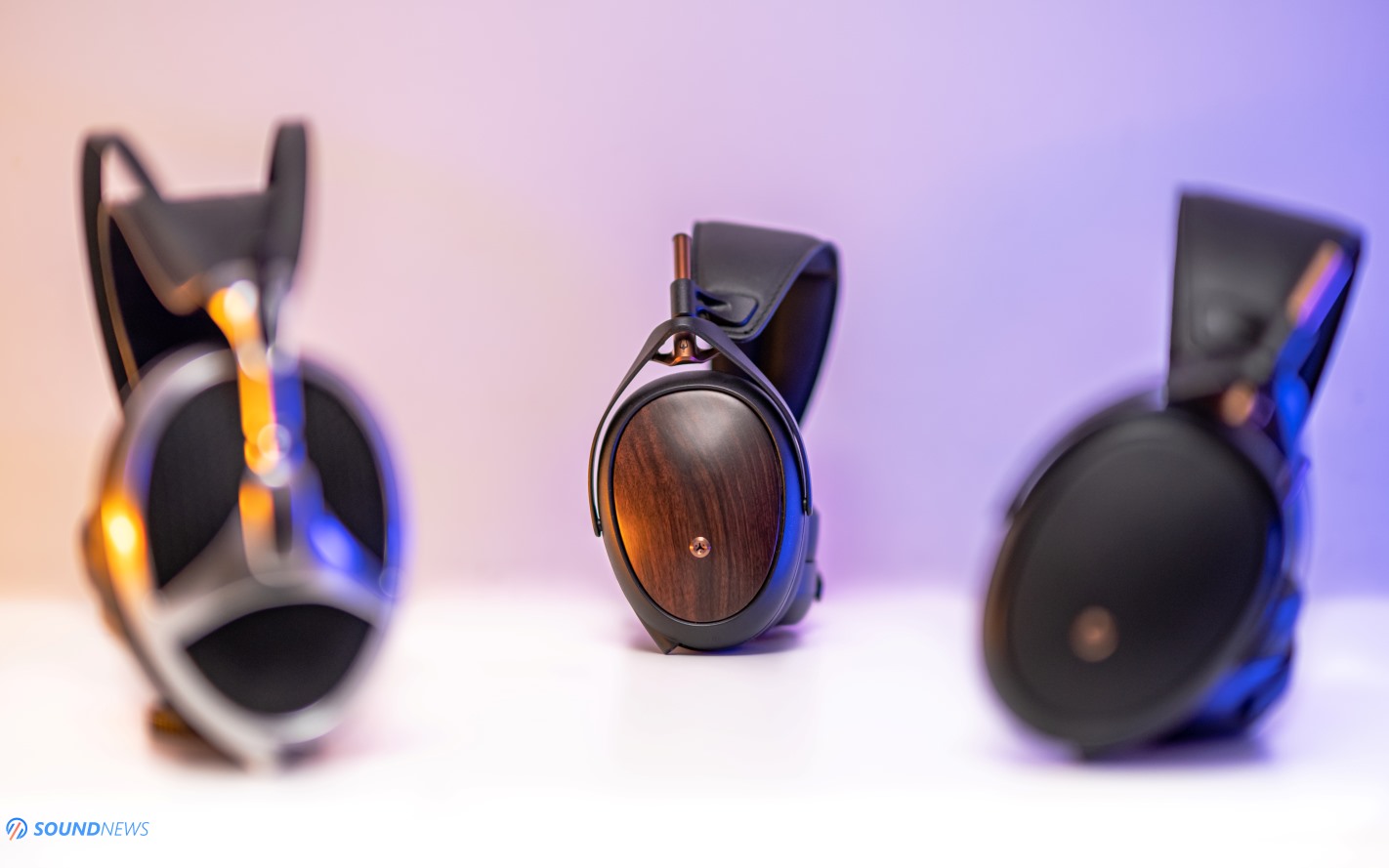
Frequency Response
VI. Bass
As a closed-back design, it’s no surprise the Liric 2 delivers stellar bass performance – impressive extension, sustain, decay, and overall quality. Though there’s a gentle roll-off in the 20 Hz region, you won’t subjectively feel it. These punch hard with any demanding modern music. There’s plenty of low-end, though perhaps not quite as abundant as the original Liric. However, the real star here is the mid-bass, which has a slight elevation compared to the rest of the spectrum. This gentle boost is what makes them so fun to listen to, adding fullness and a sense of authenticity. Honestly, all Meze headphones share this slight mid-bass rise; it’s their signature sound and something people clearly enjoy. While there aren’t any earpad variants for the Liric 2 like there are for the Empyrean 2 and Elite, perhaps we’ll see angled Alcantara pads in the future, which could even out the frequency response and offer a more neutral representation. With the stock pads, there’s a definite sense of control, which I personally appreciate, especially with solid-state amps. In comparison, the original Liric offers marginally better sub-bass but less impressive mid-bass extension. Neither is truly better or worse, but when it comes to midrange and treble, there’s a clear winner, proudly sporting those ebony wood covers.
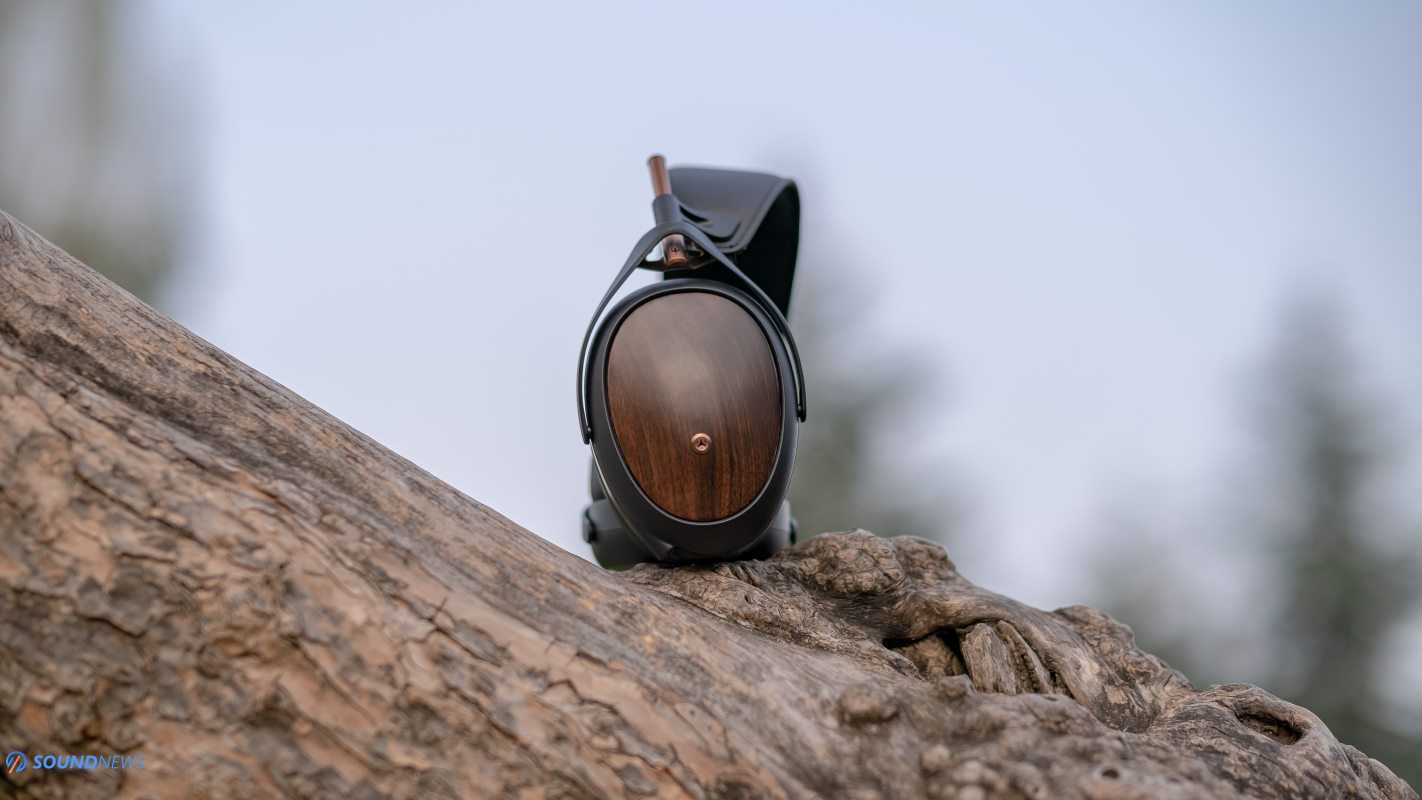
VII. Midrange
It feels almost redundant to write about the gorgeous midrange in a Meze headphone. This is why you buy a Meze – the naturalness of instruments, the guttural flow of vocals, the lingering decay of notes, the endearing melody. The Liric 2 follows the winning formula. If a fuller, denser-than-usual sound is your thing, look no further. While the original Liric was already impressive here, the second-gen adds body and a thicker tonality in the lower midrange. This small change had a huge impact on overall performance, smoothing out the rollercoaster frequency response of its predecessor. The Liric 2 offers a more even response, making music feel natural and, dare I say, more believable. If you’re coming from Fostex TH-900 MK2 or HiFiMan Audivina, these will feel like a breath of fresh air, delivering so much more emotion and warmth. When trying to win the hearts of music lovers, getting the midrange right is essential, as most of the sounds we experience in nature bloom from this region. While an impactful bass delivery can grab attention (something Meze’s mastered), a true music lover yearns for the beauty of the midrange first and foremost. I’m glad to see the evolution of the Meze sound, improving with each release, yet the one constant, the glue holding it all together, is that captivating midrange. In the realm of closed-back headphones, the Liric 2’s midrange competes with the mighty Kennerton Rognir, easily surpassing the likes of the Fostex TH-900 MK2, the original Liric, and the HiFiMan Audivina.
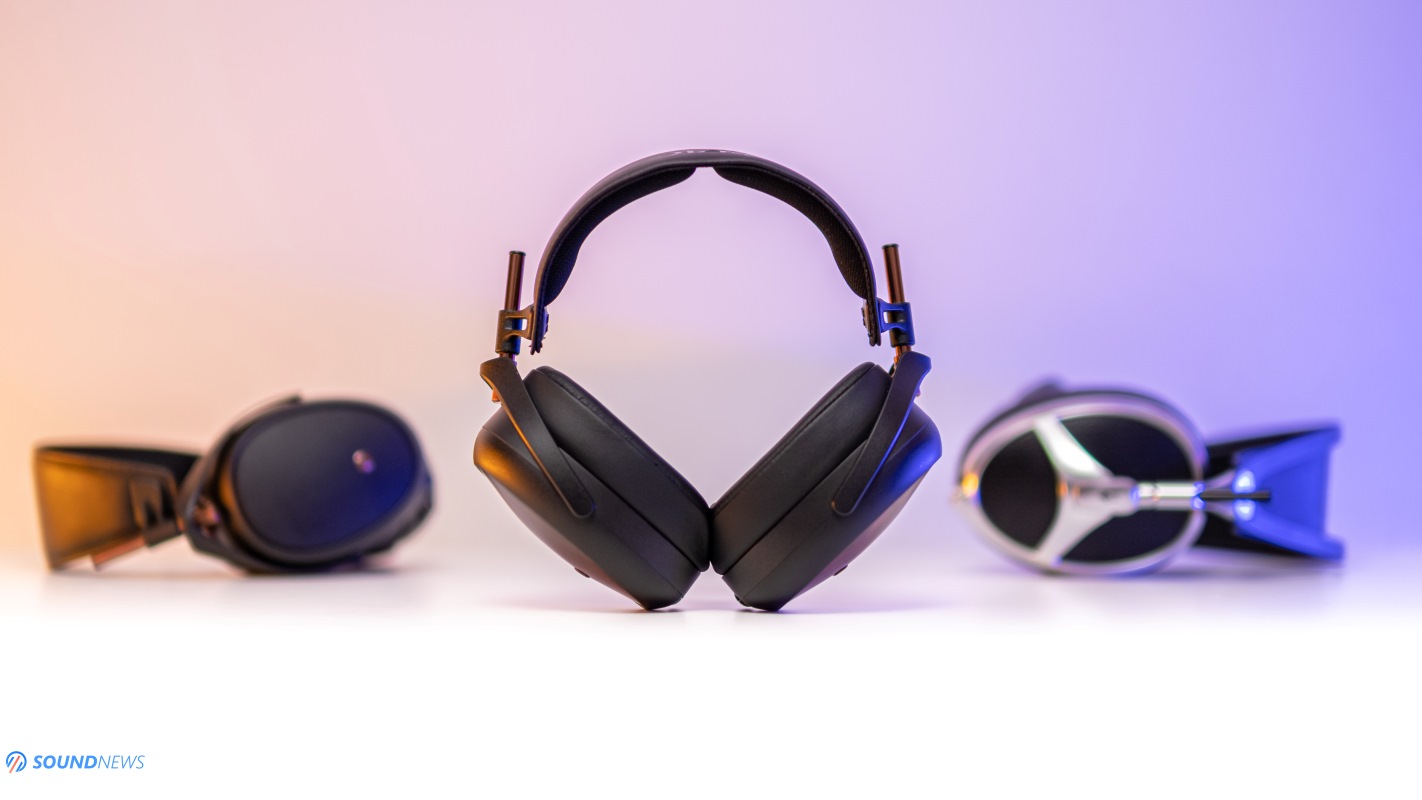
VIII. Treble
I had extensive conversations with friends who, like me, are avid headphone enthusiasts. They were among the first to buy the original Liric. When I asked what bothered them, their top two complaints were the upfront nature of the sound and peaky treble. As I have already mentioned, the Meze team stretched and widened the sound with the next-gen Liric 2, putting a wider canvas just before our eyes, so much so, that even a good deal of open-backs won’t sound as open and holographic. But there was another, much bigger challenge that Meze Audio took very seriously – the upper treble excess. After months of testing and fine-tuning, they came up with the QWRM which attenuates some of the treble in the most sensitive parts of our hearing, lowering the upper treble energy by around 3 to 4 dB. And just like that *snaps fingers* Liric 2 no longer feels harsh in long listening sessions. The extra crispness is no more, the slight metallic feel is a thing of the past, and listening fatigue isn’t residing in their cups anymore. The original Liric can light a few tracks on fire on the wrong equipment, and the HiFiMan Audivina feels like a true fire starter on every head-fi rig with its extra-hot treble delivery. Overall, their frequency response is closer than ever to linearity, adding just an extra dose of fun down low and a velvety texture up top.

IX. Meze Liric 2 Detailed Measurements
After offering my subjective impressions, let’s check how things are looking under a magnifying glass. I used Chord DAVE DAC which was doing all the heavy lifting. The measurement rig used was a MiniDSP E.A.R.S. system calibrated with HPN (Original Headphone Compensation) files. Please note that E.A.R.S. is not following any IEC standards, meaning that my readings can’t be used as reference measurements or anything like that. I’m doing them for fun, getting a general idea about their sound signature. I measured them a couple of times, as both channels needed to be matched, and finding the perfect spot on the test jig wasn’t so easy. No side pressure was applied to the ear cups, they stood still in their natural position.
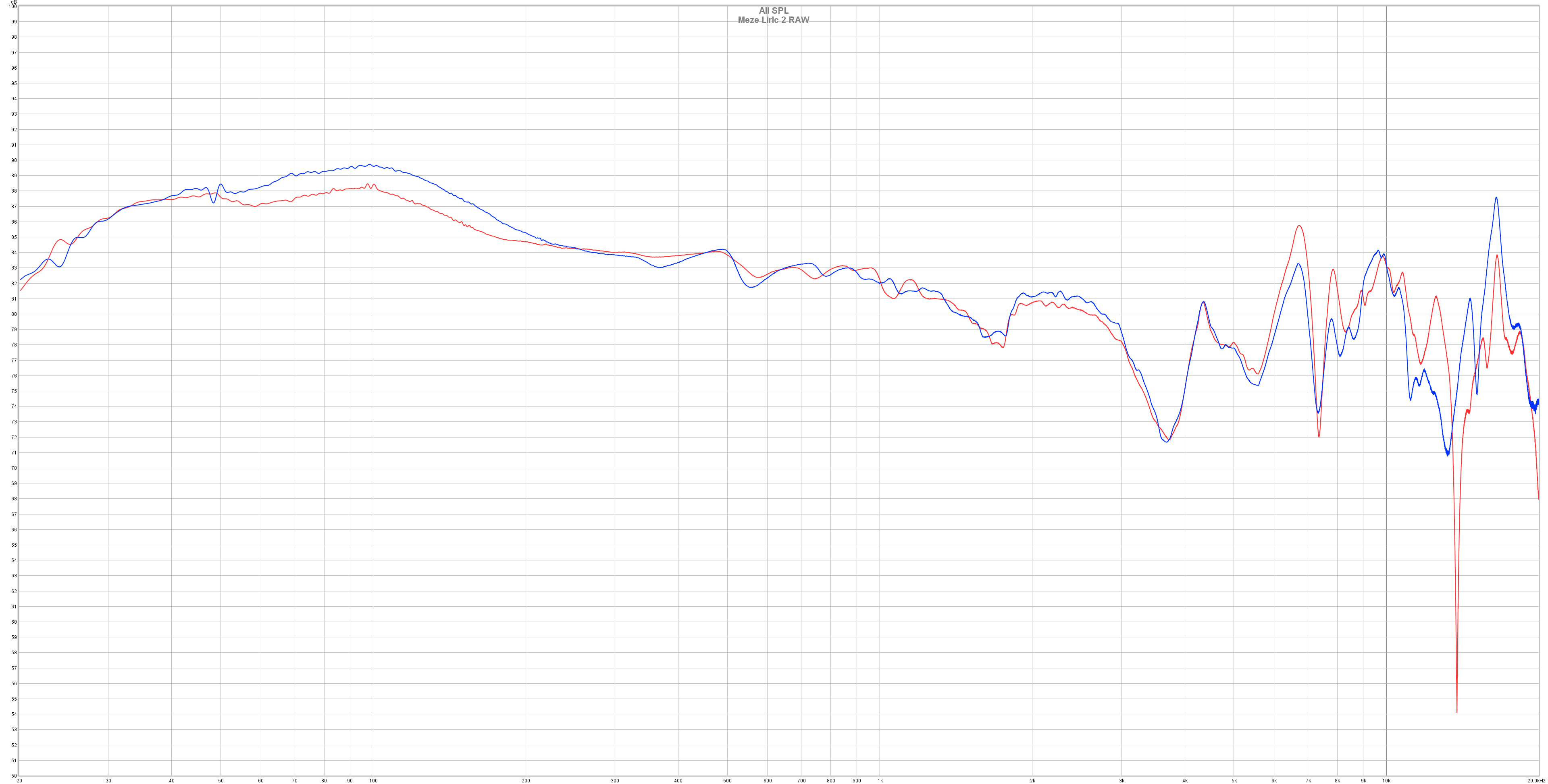
This is their RAW frequency response without any smoothing applied, please disregard the slight channel mismatch in the mid-bass and upper treble. Please note that I zoomed this reading quite a lot, so you could better see all the deviations between 60 and 100 Hz and then between 10 and 14 kHz, but I couldn’t hear them while listening to music.
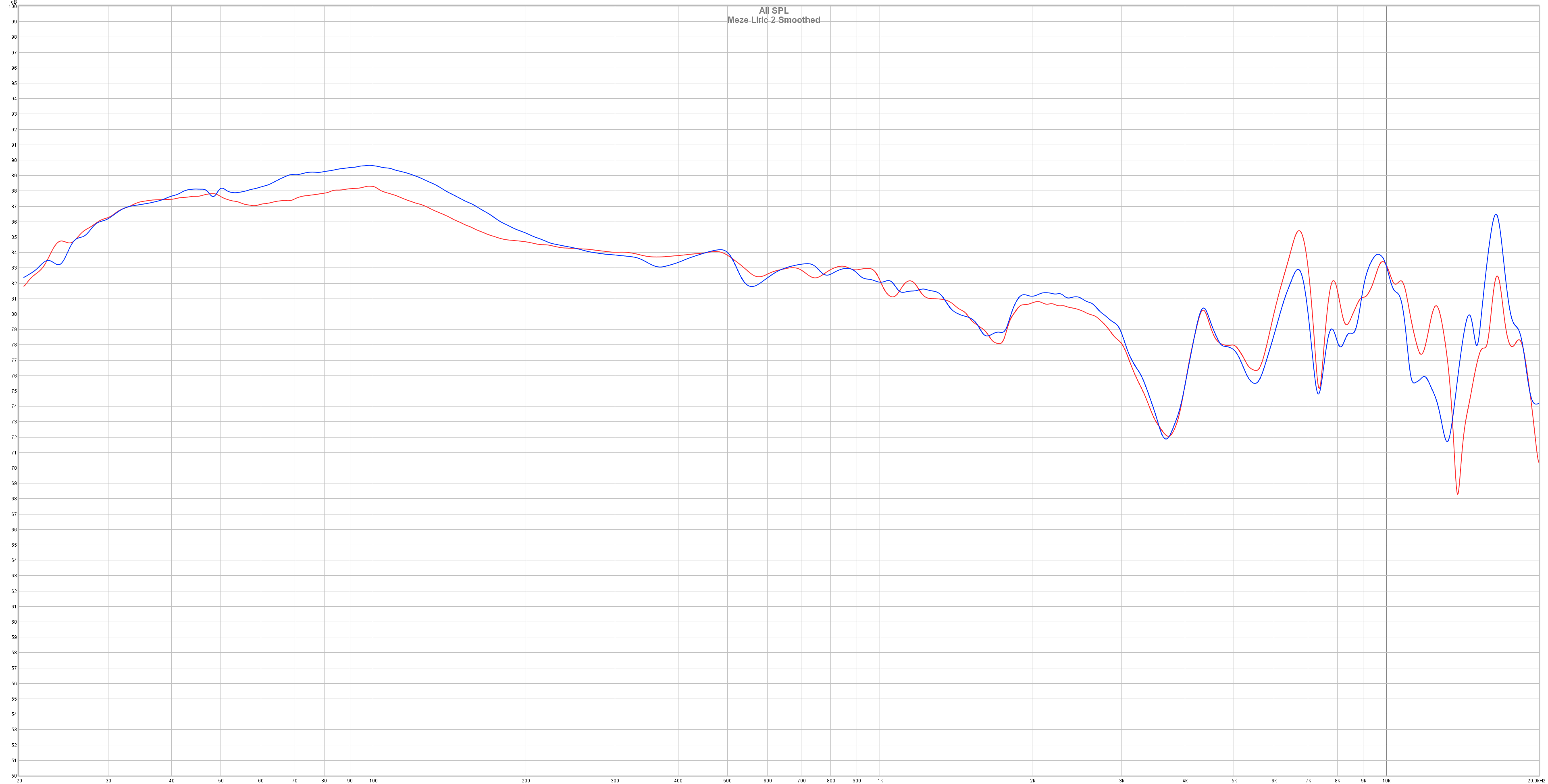
After applying a gentle 1/24 smoothing, I got a slightly different graph and as you can see, they offer a slight bump between 30 and 300 Hz, suggesting an exemplary bass and midrange performance. You can see a minor roll-off in the sub-bass and a stable upper midrange. The most sensitive part of our hearing looks much better compared to the original Liric and the top octave has plenty of driver movements that will offer you back some brilliance and a sensation of cleanness. All in all, this is a nicer FR reading compared to the original Liric and a much better one compared to that of the 99 NEO and 99 Classics.
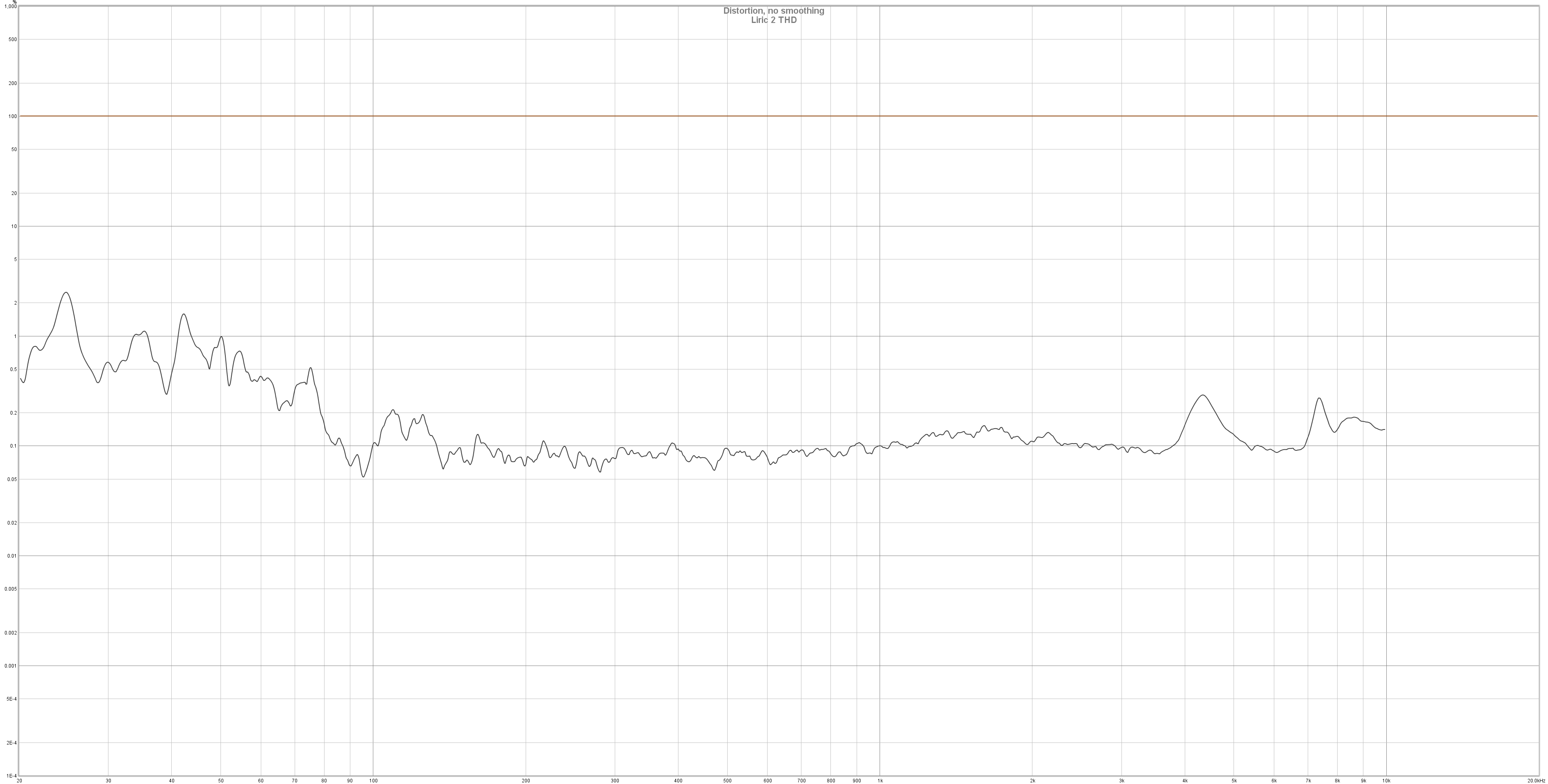
Their THD reading is great, it looks a bit better than their 109 PRO and 99 Classics and very similar to the Elite and Liric, reaching as high as 2% in the bass region and 0.3% in the treble, but usually staying in the neighborhood of 0.1% which is simply great.
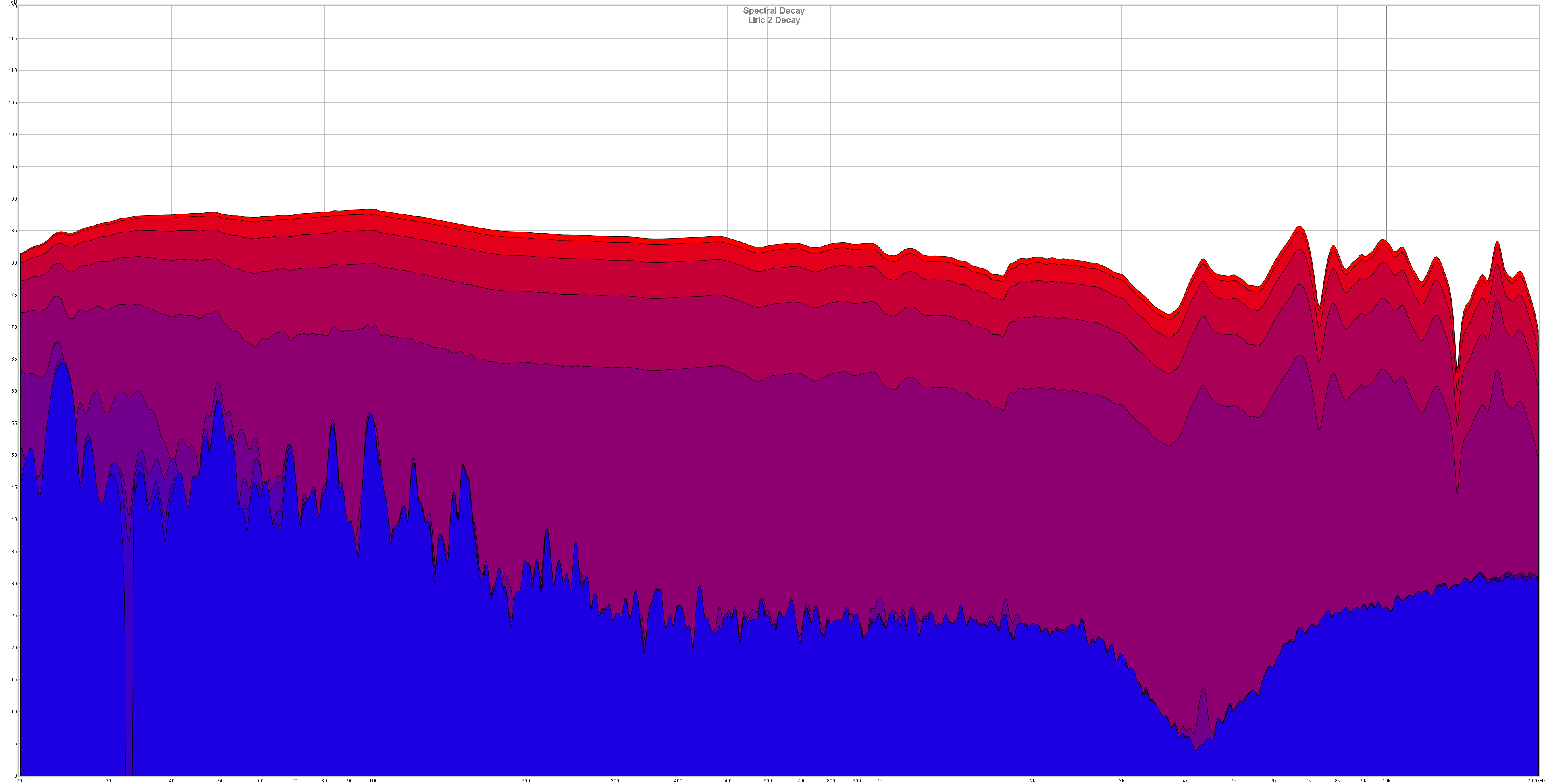
Spectral decay looks good and after sending a 300 Hz sweep tone at 84 dB, it drops to 5 dB at the lowest point and rises to 64 dB at the highest point after a time frame of 160 ms, usually staying at around ~25 dB, which leads to a faster driver movement compared to their 109 PRO and even, Empyrean.

Waterfall combines the FR plot and decay into a single graph and you can see their FR from a different angle including their impulse response.
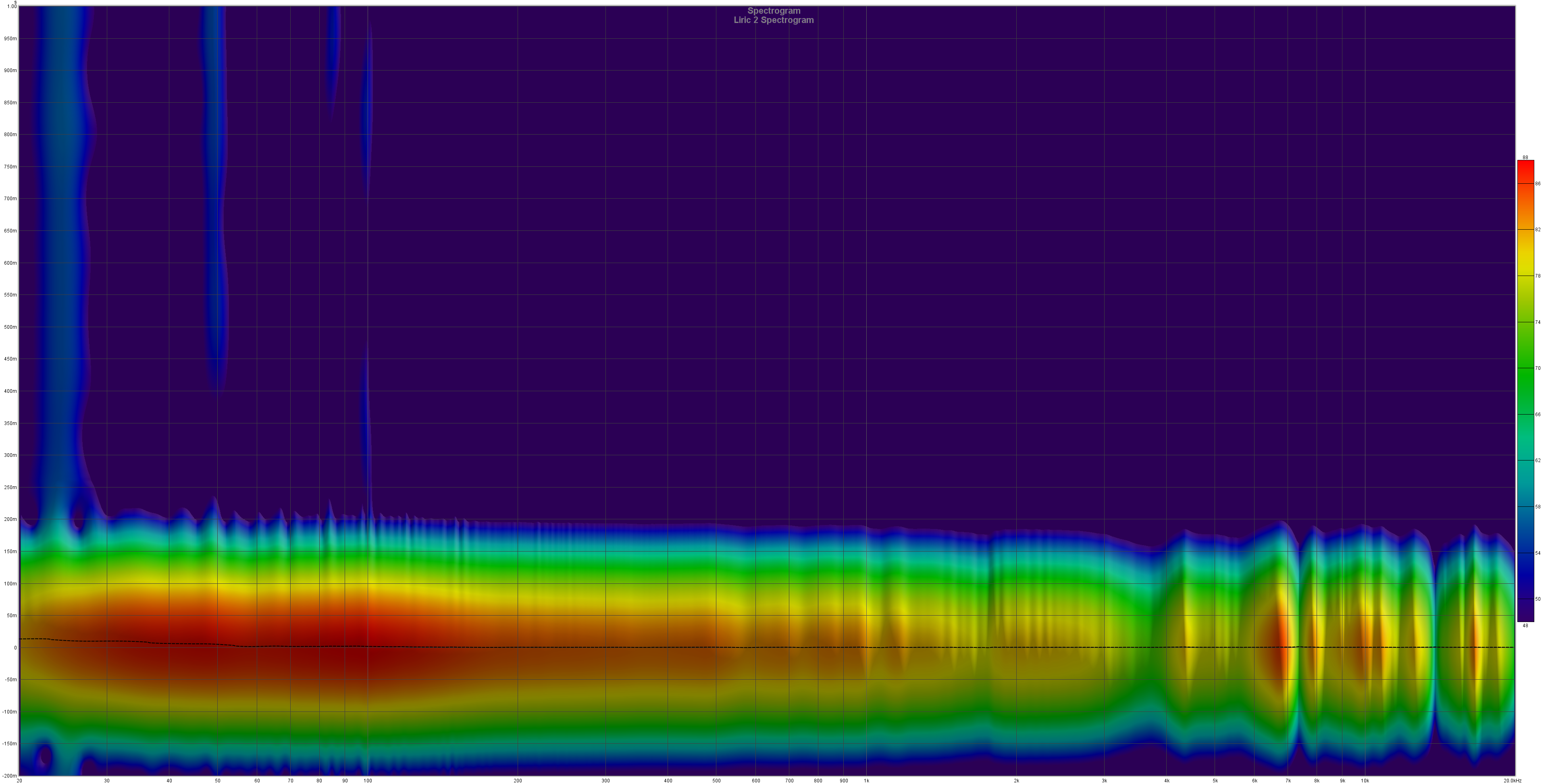
The spectrogram shows a minor ringing happening between 20 and 30 Hz and another one at 50 Hz, but I don’t see nasty distortions building up anywhere else. Closed-back headphones usually have some of these, but Liric 2 looks nowhere near as bad as the readings of the Fostex TH-900 MK2 and HiFiMan Audivina.
Overall, Meze has finally found a middle ground for their closed-back headphones, improving their frequency linearity, distortion, and decay, at the cost of a gentle sub-bass roll-off.
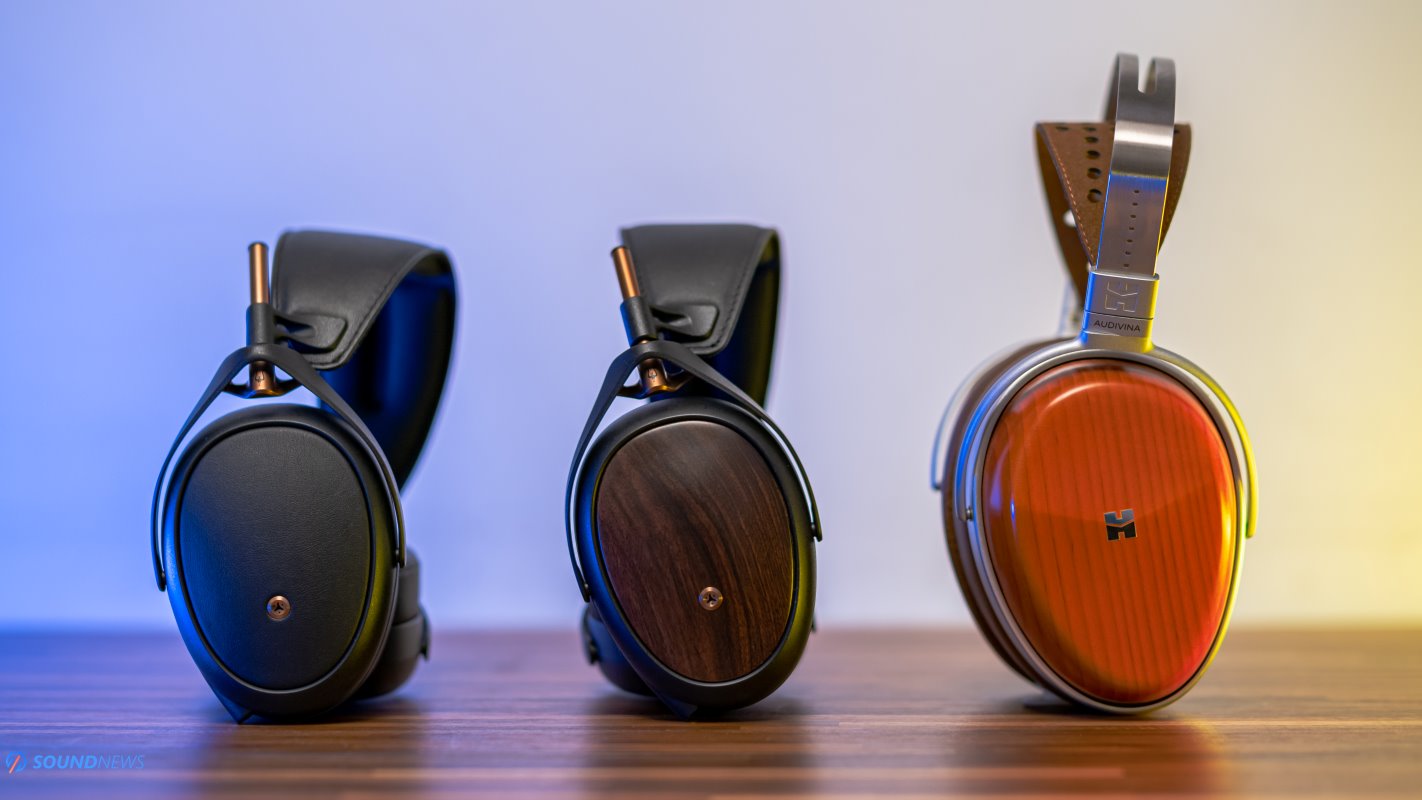
X. Comparisons
Meze Liric 2 ($2000) VS Meze Liric OG ($2000) VS HiFiMan Audivina ($1999)
If you’re a manufacturer and my words are going to offend you, then please accept my apologies, but understand that I need to stay honest with my readers and viewers. My opinions are always my own and that isn’t going to change anytime soon. I’ll be as objective as possible, without taking into account my personal preference. If you’re an avid reader, please enjoy the showdown.
All my comparisons are done in the morning, after a hot shower, two poofs of Audispray, a hot coffee, and after volume matching them at 90dB with the MiniDSP E.A.R.S. All these are mandatory, as I know that my hearing and mood levels would be at their prime.
1. When it comes to looks, build quality and comfort, well, let’s just say that the HiFiMans can’t reach the craftsmanship and the exquisite feel that Meze Audio is building. In my view, there isn’t a more sophisticated build than their Elite and Empyrean 2, choosing smooth lines and long-lasting materials and the same can be said about either version of the Liric. Audivina feels less compelling in my hand, they somehow feel hollow as if their cups aren’t sculpted from thick wood. Although much bigger and imposing, Audivina doesn’t feel that sturdy and since there is no way to change the earpads, these aren’t scoring top points.
- Meze Liric 2: 10
- Meze Liric: 9
- HiFiMan Audivina: 7
2. When it comes to sensitivity, there is a minor difference between them. The original Liric is the most sensitive, followed by the Audivina and then by the Liric 2 which demands a healthier current flow for a similar SPL. Portable devices work great with the first-gen Liric and some of them not so much with the Audivina or the Liric 2.
- Meze Liric 2: 9
- Meze Liric: 10
- HiFiMan Audivina: 9.5
3. Regarding frequency response top to bottom, Liric 2 offers the most even frequency response and I believe they have the most refined treble performance as well. Liric OG follows next, having a less impressive upper midrange and top octave. As for the Audivina…I guess I’ll leave a graph and I will let you decide if you ever saw anything like this. I’m sure I didn’t in several years of headphone measuring. I don’t understand how such a headphone entered production 😮
- Meze Liric 2: 10
- Meze Liric: 9
- HiFiMan Audivina: 5
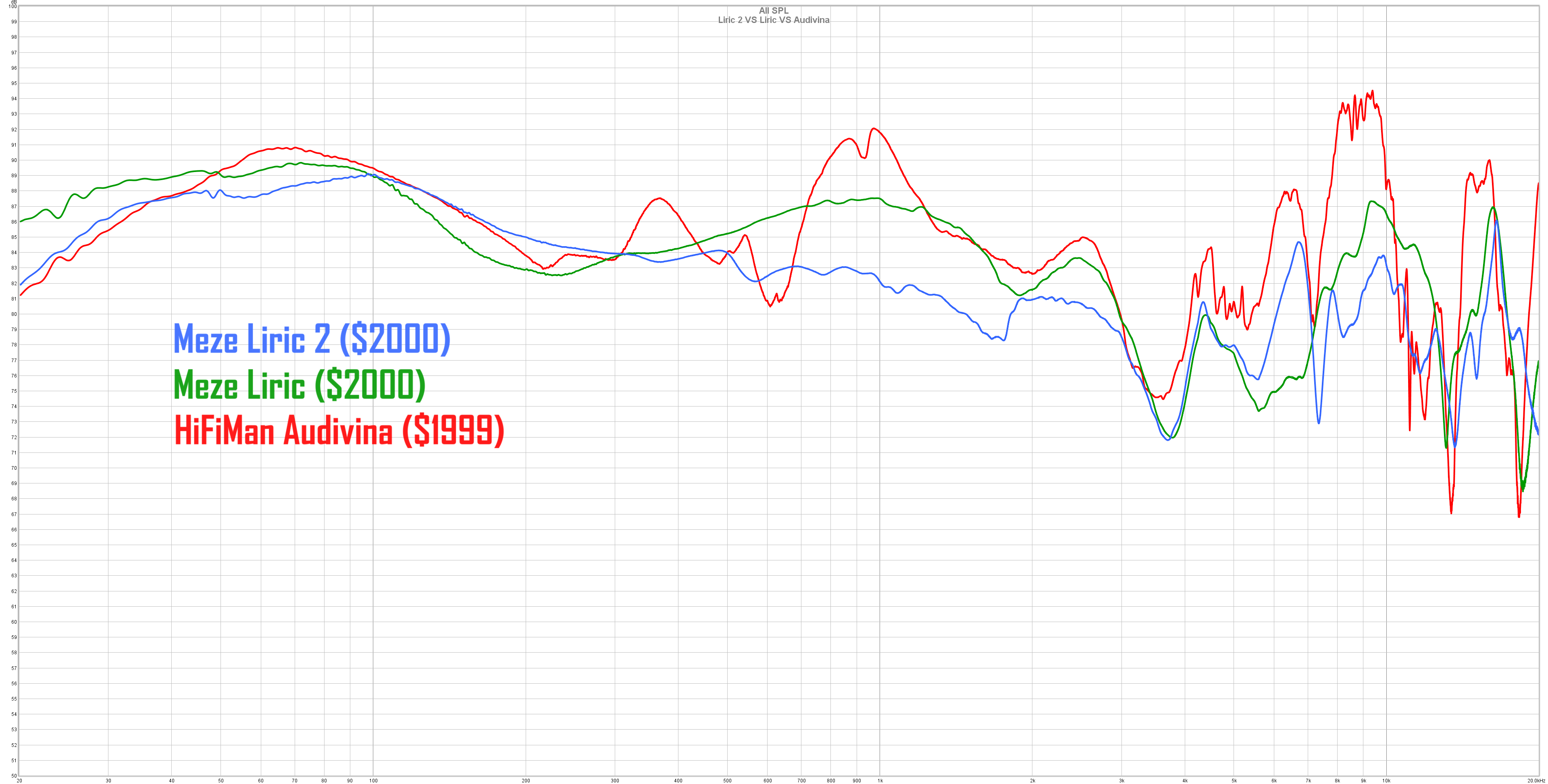
4. When it comes to transients as a whole, the Audivina is leading the pack by a slight margin, they have a slight edge over both Lirics, due to a faster impulse response and decay. The difference is minor and in a real-life scenario, I can’t say that one is faster sounding and the other two are slower. I find them all fast sounding, except that the HiFiMans are a tad snappier when shifting from down to up-tempo beats. Electronic music is clicking into place with all three, however with acoustic stuff…Audivina barely passes the exam.
- Meze Liric 2: 9.5
- Meze Liric: 9.5
- HiFiMan Audivina: 10
5. Moving on to the soundstage, we have different ear cup sizes and different presentations. Audivina shows more information in the middle with very few sounds escaping your peripheral hearing, Liric 2 puts more sounds to your sides and Liric OG shows little information in the middle. Liric 2 feels more natural in its presentation somehow mimicking the sound of open-back headphones, followed by the Audivina and then by the original Liric.
- Meze Liric 2: 10
- Meze Liric: 9
- HiFiMan Audivina: 9.5
6. When it comes to transparency and detail retrieval, all of them are highly resolute, with the exception that Audivina feels so uneven, that some sounds feel extra crisp, while others are thrown into the abyss, never to be heard again. Audivina are resolving sounding cans, but there are simply too many gaps in their frequency response, removing information from your tunes in a very unnatural way. Both versions of the Liric sound clean and transparent, but since there is less driver ringing with the second-gen, these feel more acoustically transparent and closer to the source material.
- Meze Liric 2: 10
- Meze Liric: 9
- HiFiMan Audivina: 7
7. The most interesting part I left for last and that’s their tonality, or how natural and believable they can sound. Unsurprisingly, both versions of the Liric are leading the pack, but since there is a buff in the lower-midrange section on the second generation, Liric 2 is the clear winner of this showdown. Liric OG follows next and Audivina’s trainwreck of a frequency response feels like an unmitigated mess, scoring the least points from the bunch.
- Meze Liric 2: 10 (easy to listen to, sounds natural, good timbre)
- Meze Liric: 9 (very similar sounding with a slight upper treble boost)
- HiFiMan Audivina: 6 (I don’t have the words to describe their tonality)
8. Final Results
- Meze Liric 2: 68.5 points
- Meze Liric: 64.5 points
- HiFiMan Audivina: 54 points
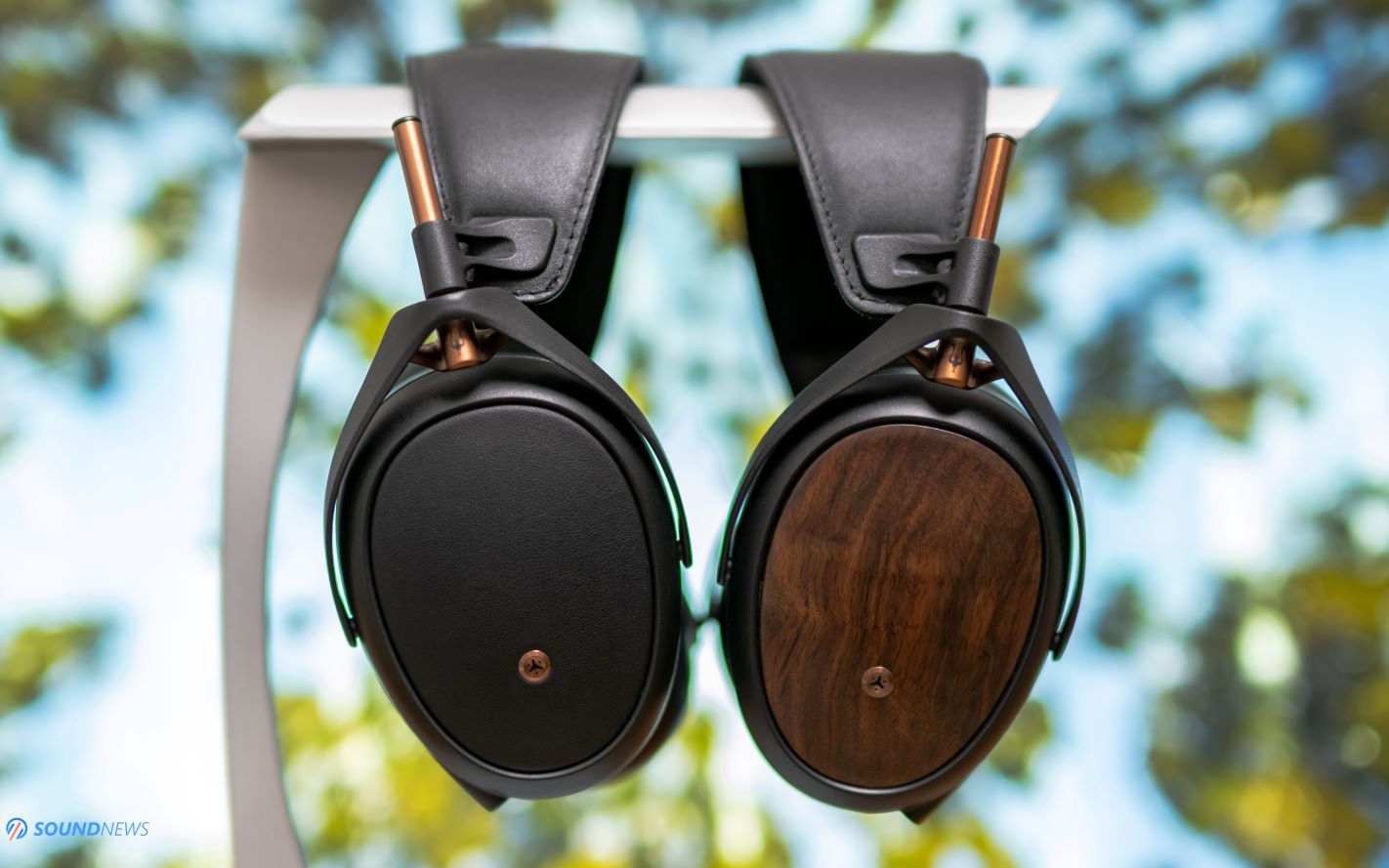
My Conclusions
And here we have it! A brand-new flagship closed-back planar headphone from the house of Meze Audio that no longer pierces your eardrums or makes you feel claustrophobic in long listening sessions. It seems that all the feedback received for the OG Liric was taken to heart, resulting in a dramatic improvement in sound staging capabilities, imaging, and most importantly, frequency response. A team that is so receptive to constructive feedback truly has my respect.
After doubling their impedance, you’ll need slightly more power to unleash the same dynamic impact as the original Liric. However, this slight inconvenience is a small price to pay for a more complete and refined closed-back headphone, one capable of rivaling even a select few open-back flagships. I’m delighted that the braided PCUHD copper cable, which sells separately for a hefty $249, is now bundled with the Liric 2 (just be sure to order the right connector: 3.5mm, 4.4mm or 4-pin XLR). I’m also pleased that the earpads are no longer glued, but magnetically attached. Add a splash of color with the wooden covers, and you have a headphone that radiates excellence and has earned our highest honors.

No matter how I scrutinize the Liric 2, finding genuine flaws is a significant challenge, especially when considering its price point. At this level, its only true competitor may be the DCA E3, another masterfully crafted headphone with a similar price tag. I’ll be putting them head-to-head at the Munich High-End Show this year and will keep you updated on how the Liric 2 compares.
Until then, the Liric 2 will undoubtedly be my travel companion to various HiFi shows. If you happen to spot a bearded dude sporting these incredible headphones, don’t hesitate to offer a wink, a fist bump, and a warm hello!
Meze’s Liric 2 will cost you $2000 and is available through their International & European webstore or on Apos Audio via this link. If you’re a fellow audiophile or have any burning questions, please drop a comment below!
PROS:
- From the moment you open the box, a sense of luxury unfolds. The presentation is top-notch, and that bonus PCUHD copper cable is a delightful surprise.
- Visually striking yet surprisingly comfortable, the build quality reflects Meze’s reputation. Even with their substantial size, I found myself immersed in music for hours on end.
- The switch to magnetic earpads is a stroke of genius. Easy to swap, offering future upgrade potential.
- For the price point, they’re remarkably revealing, pushing close to the Elite’s level of detail.
- Prepare for a visceral bass experience on the right setup. As you upgrade your source, that low-end tightens and gains remarkable clarity
- Gone is the upper-treble harshness of the originals, banishing listening fatigue for good.
- The Liric 2 achieves a more balanced frequency response that doesn’t sacrifice excitement.
- Prepare to be surprised – these closed-backs create a sense of space that rivals many open-back headphones.
- They deliver the detail you crave with an engaging musicality that’s just plain fun.
- Though premium, the Liric 2’s upgrades truly justify the price
CONS:
- Compared to their predecessor, they’ll need a bit more juice to reach the same volume.
- It would be fantastic to see Meze offer angled Alcantara pads as an optional extra down the road. Pretty please!
ASSOCIATED EQUIPMENT:
- HiFi Racks: WoodYard Suspended Triple & Baby Modular
- DACs: Chord Electronics DAVE, Rockna Wavedream Signature XLR
- Wireless Streamer & Music Server: Rockna Wavedream NET 4TB
- Headphone Amps, Trafomatic Primavera, Enleum AMP-23R, Ferrum OOR & HYPSOS, Burson Audio Soloist Voyager, Flux Lab Acoustics Mentor 2X
- IEMs: Westone Mach 50, Hiby ZETA, FiiO FX15, HiFiMan Svanar, 7Hz Timeless AE, Kinera Skuld & others
- Full-sized headphones: Meze Liric 2, Liric, Elite, 109 PRO, HiFiMan Susvara, Arya Organic, Audivina, Erzetich Charybdis & Phobos V.2021, Sennheiser HD800S, Kennerton Rognir (planar) & Vali, Apos Caspian, Sendy Peacock & Apollo, HarmonicDyne Elite & Poseidon, others
- Preamps: Chord Electronics Ultima 3 Pre
- Power Amps: Chord Electronics Ultima 5, Burson Timekeeper 3X GT (x2)
- Loudspeakers: Raidho TD 2.2
- Interconnects: Crystal Cable Reference2 Diamond (x3), QED Reference (x2)
- USB Cables: Supra USB Excalibur (x2), Chord C-USB, Matrix Hi-Fi USB
- HDMI Cables: Audioquest Dragon DBS, Audioquest Diamond DBS
- Speaker cables: Crystal Cable Reference2 Diamond
- Power Cables: Crystal Cable Monet (x2), Crystal Cable Reference2 Diamond (x2), iFi Audio SupaNova (x2)
- Balanced Isolation Power Conditioners: PLiXiR Elite BAC1500 (headphone setup), KECES IQRP-1500 and P14 (stereo setup)
